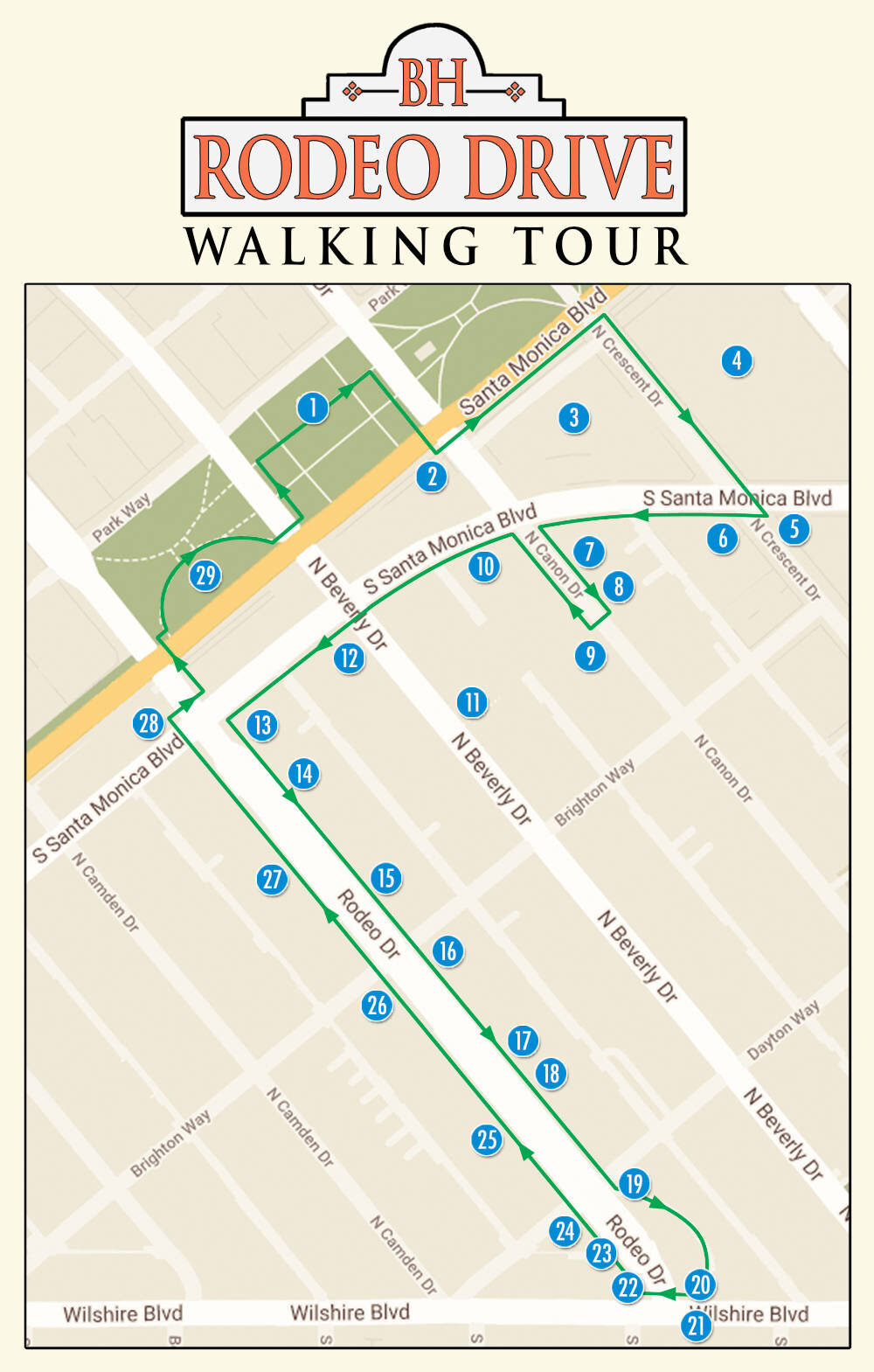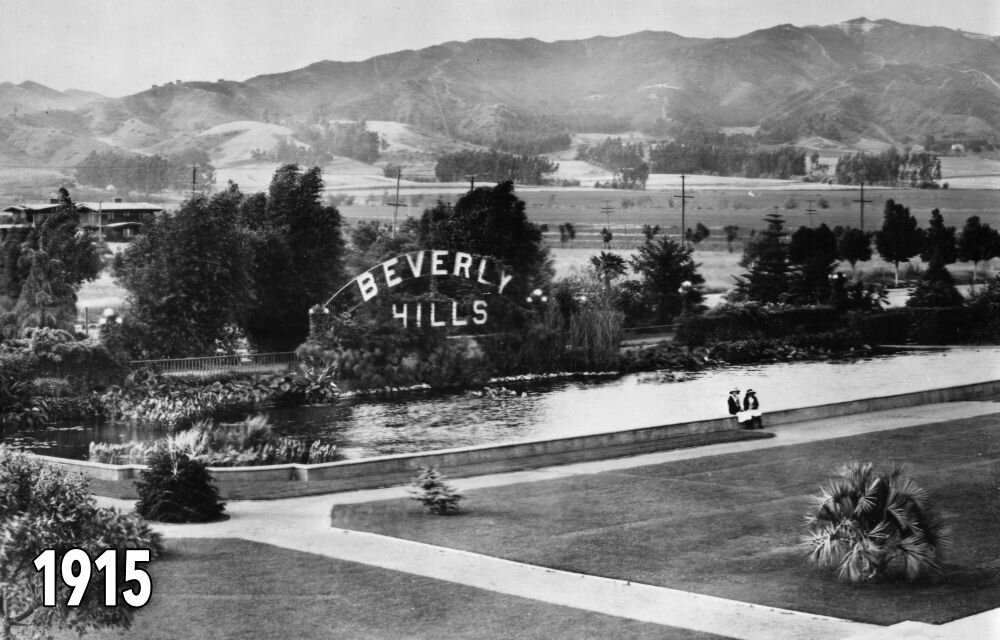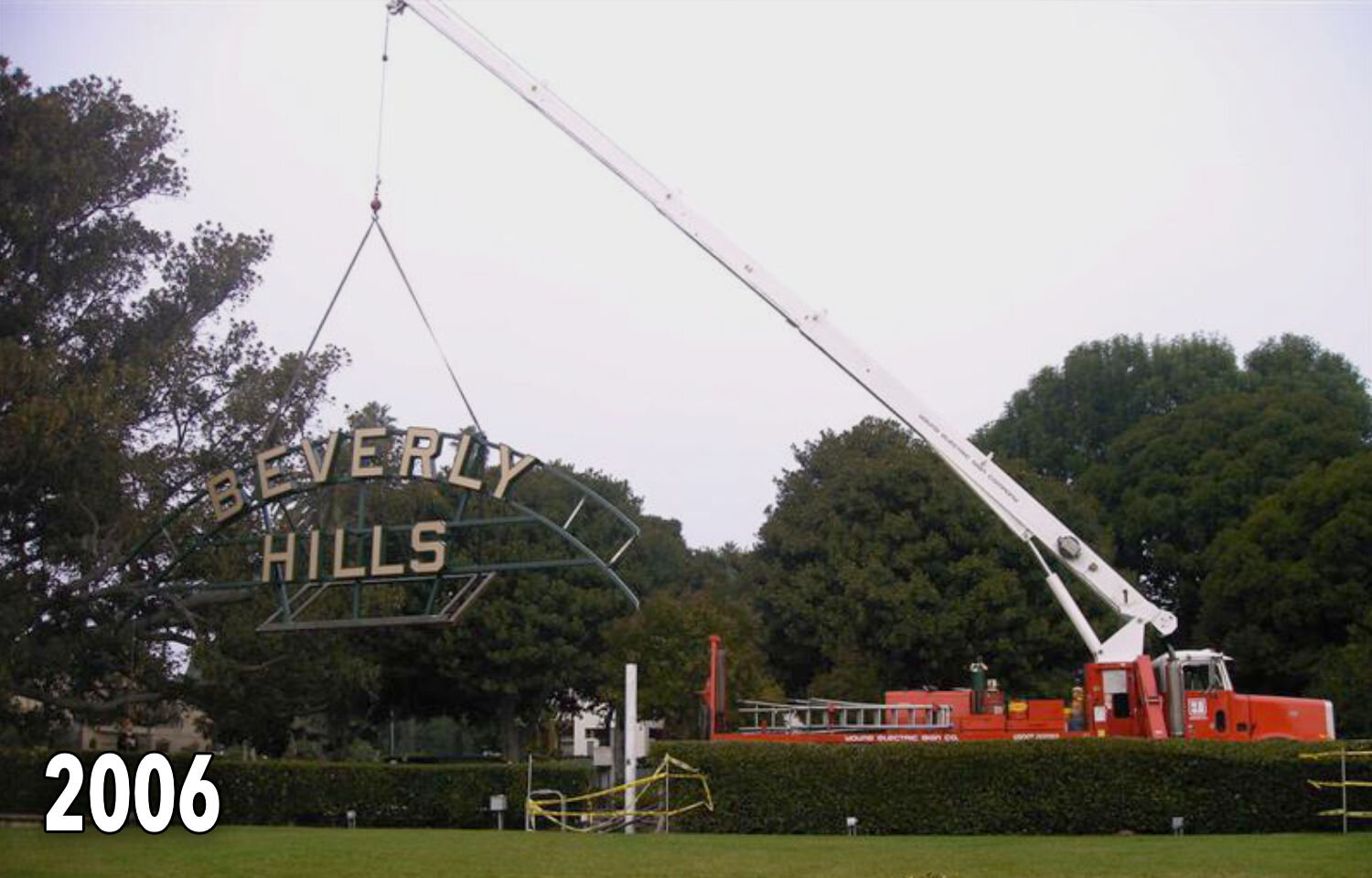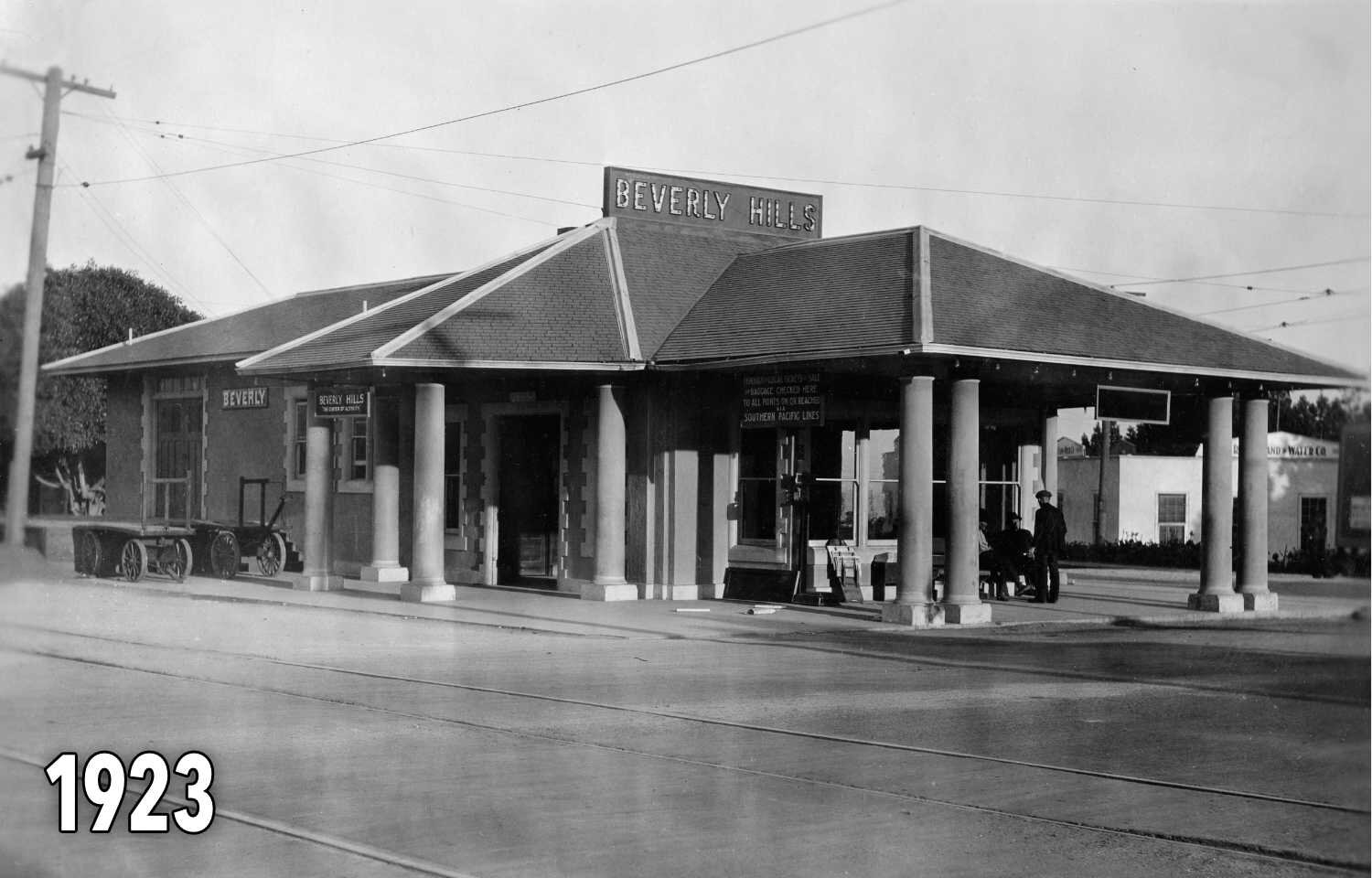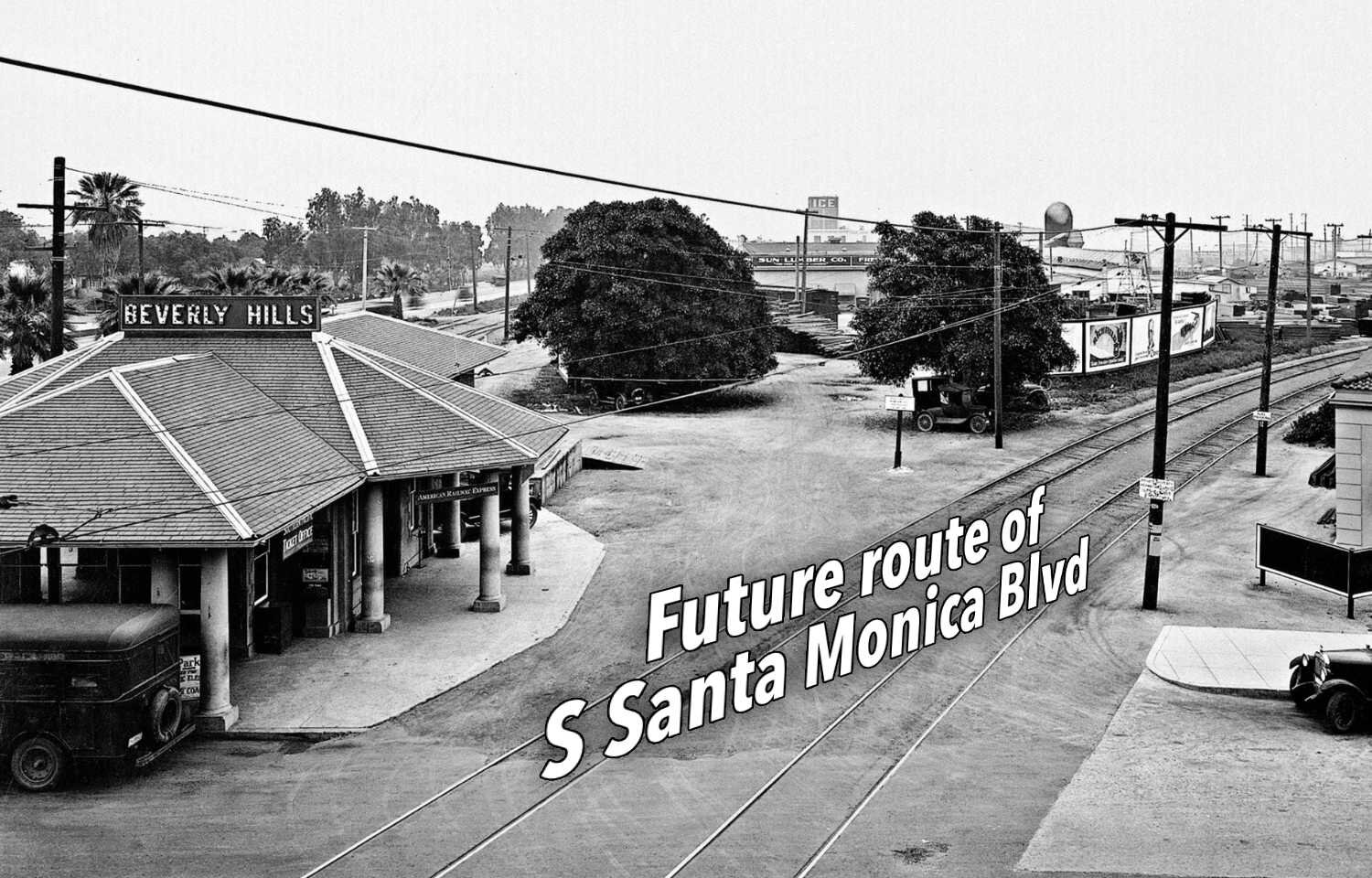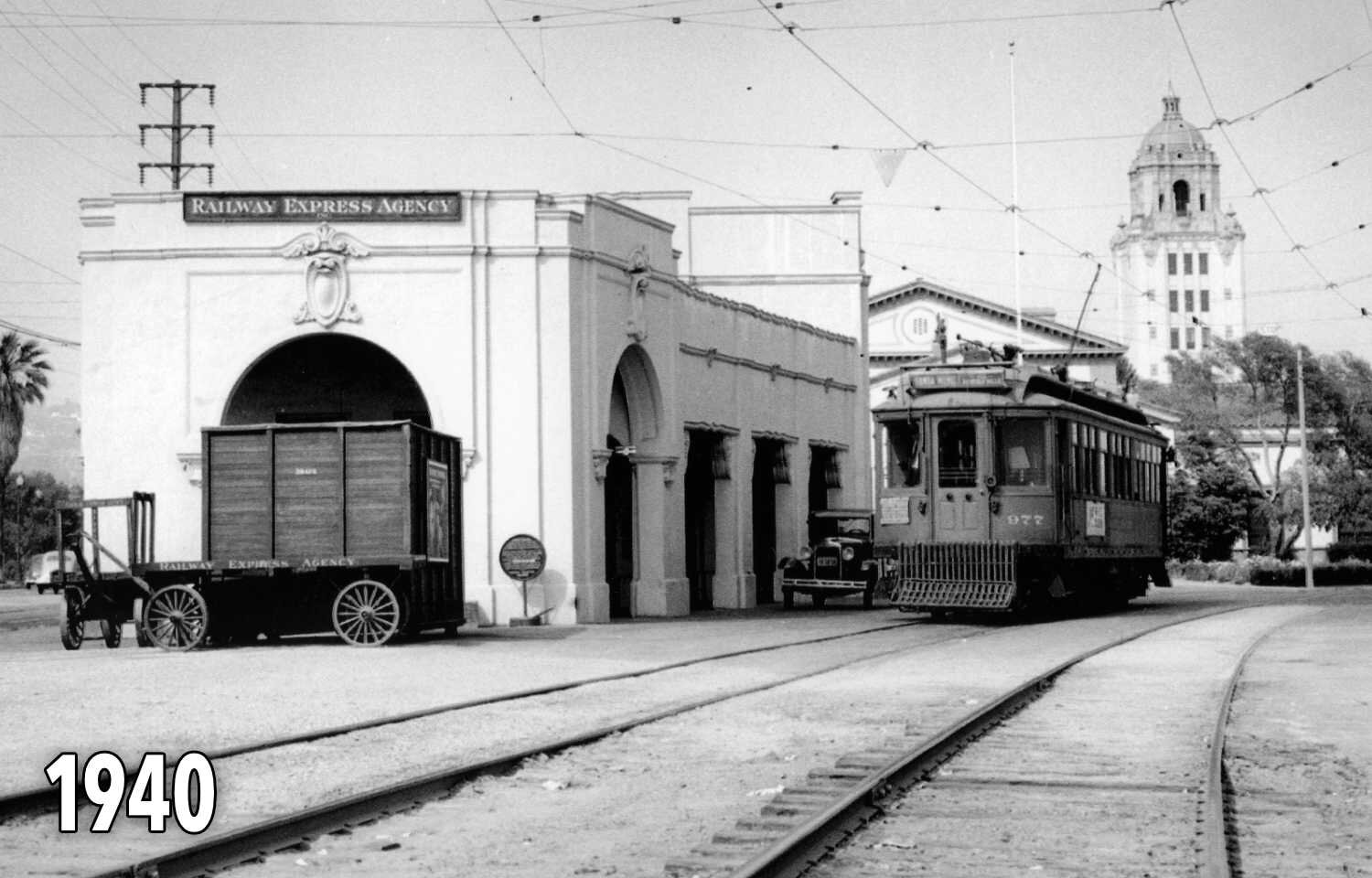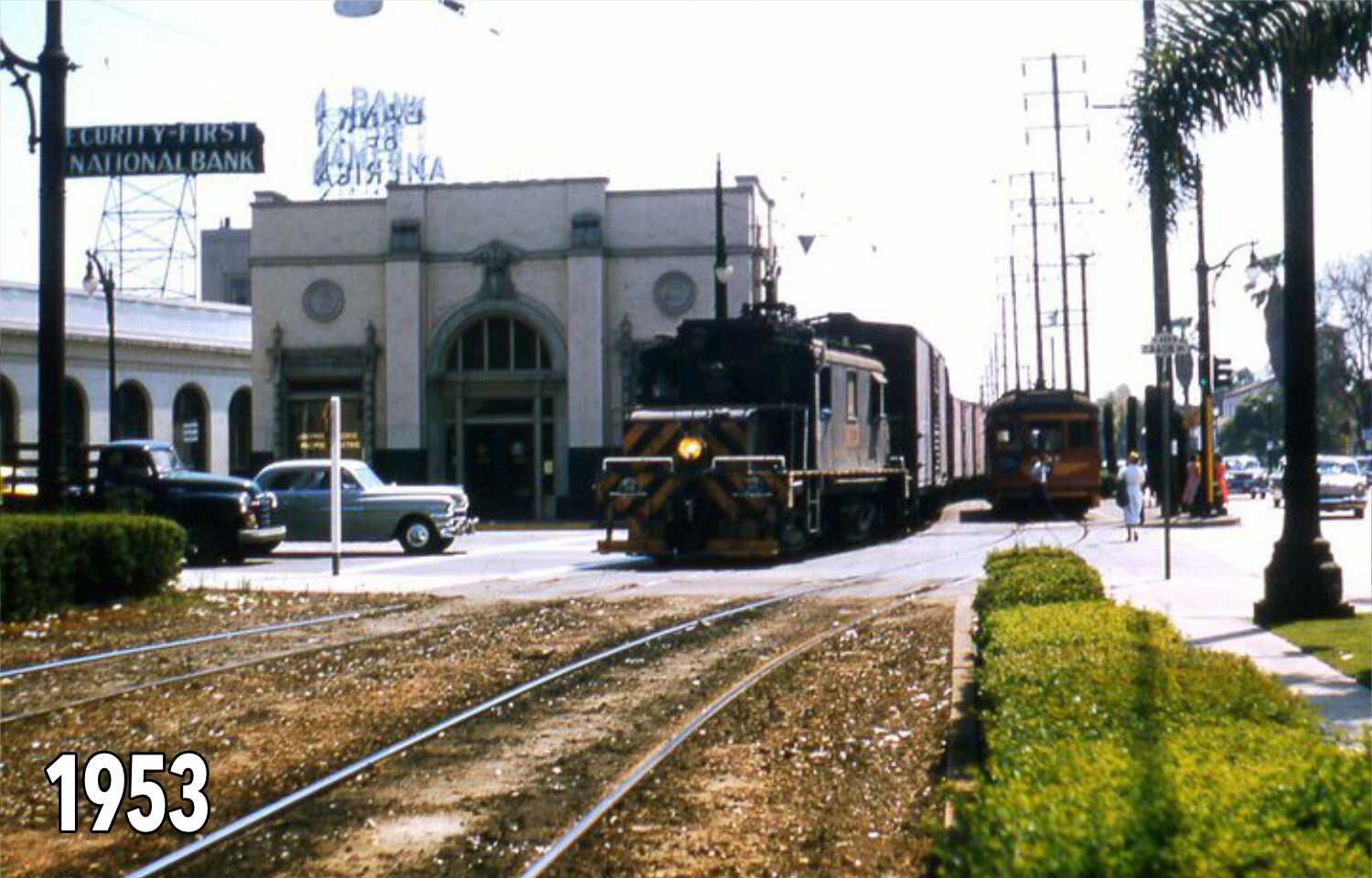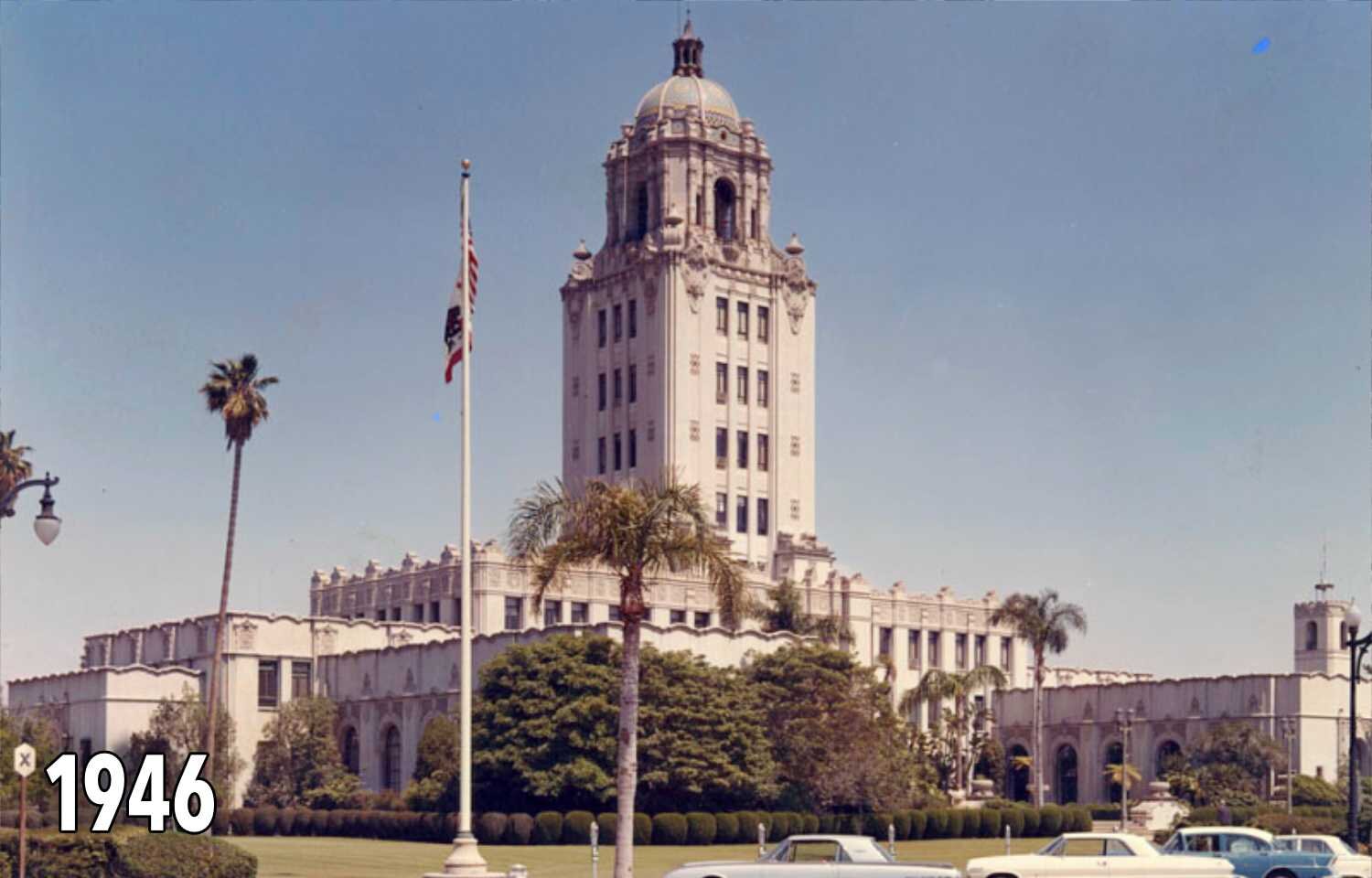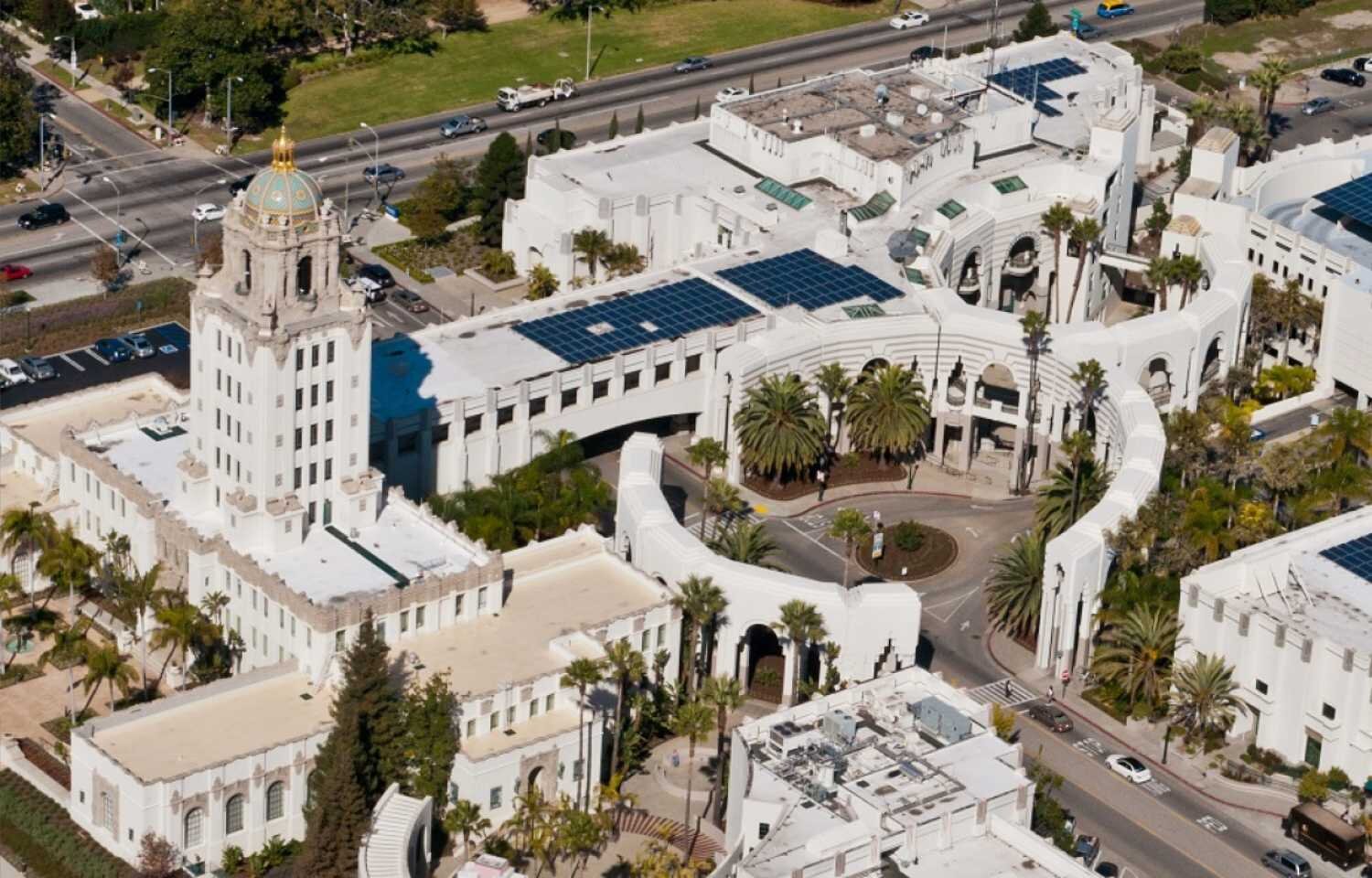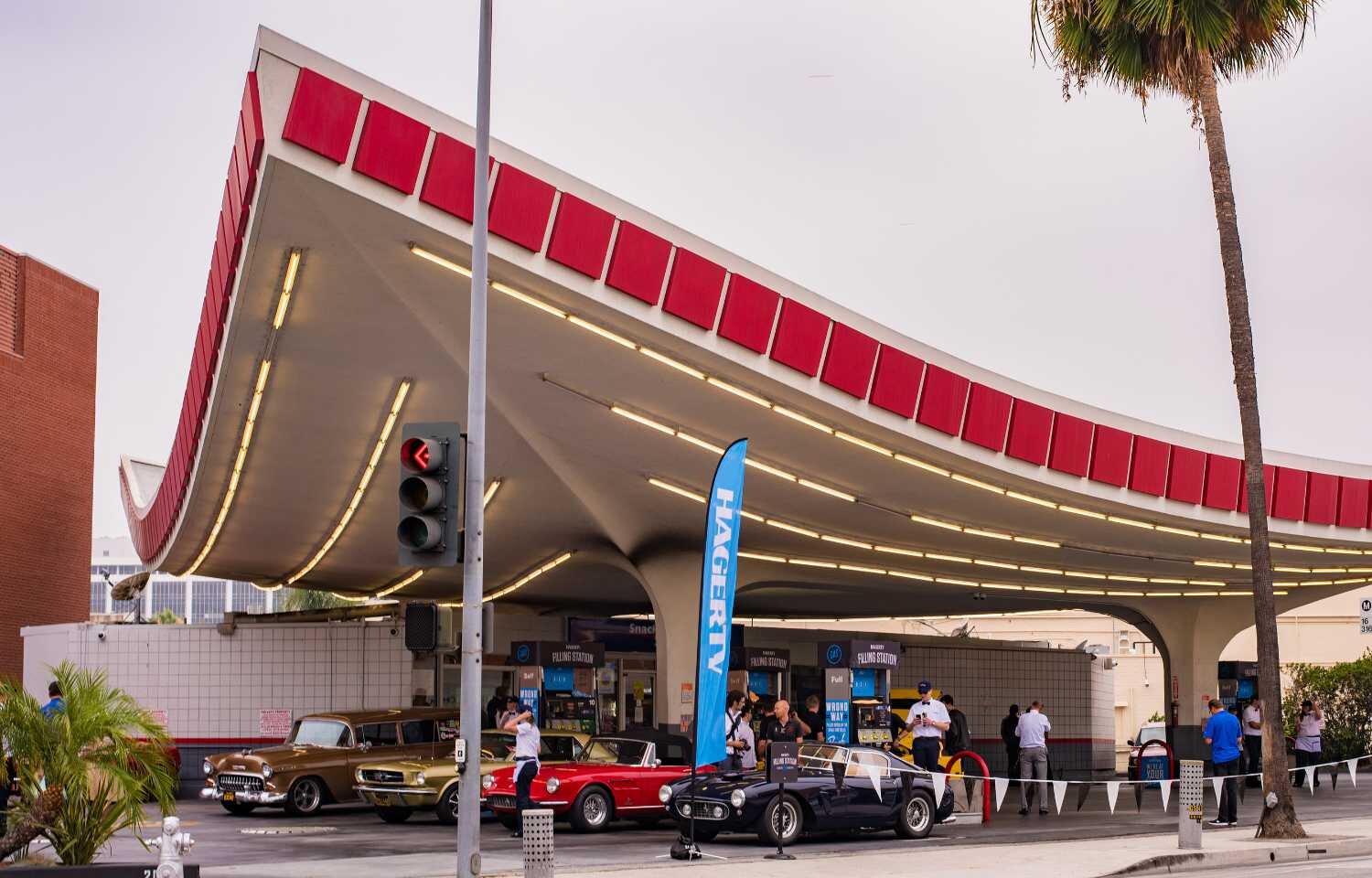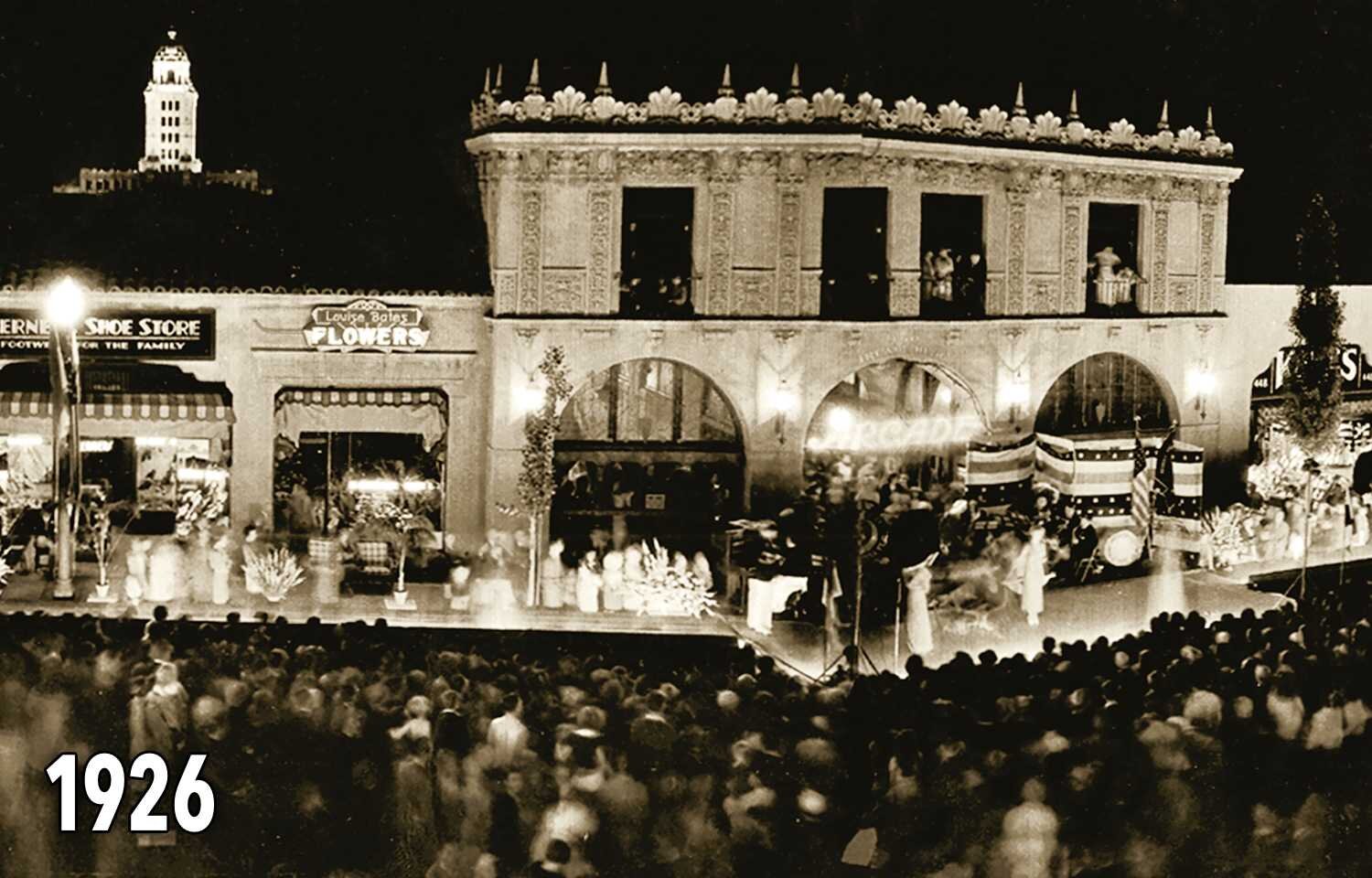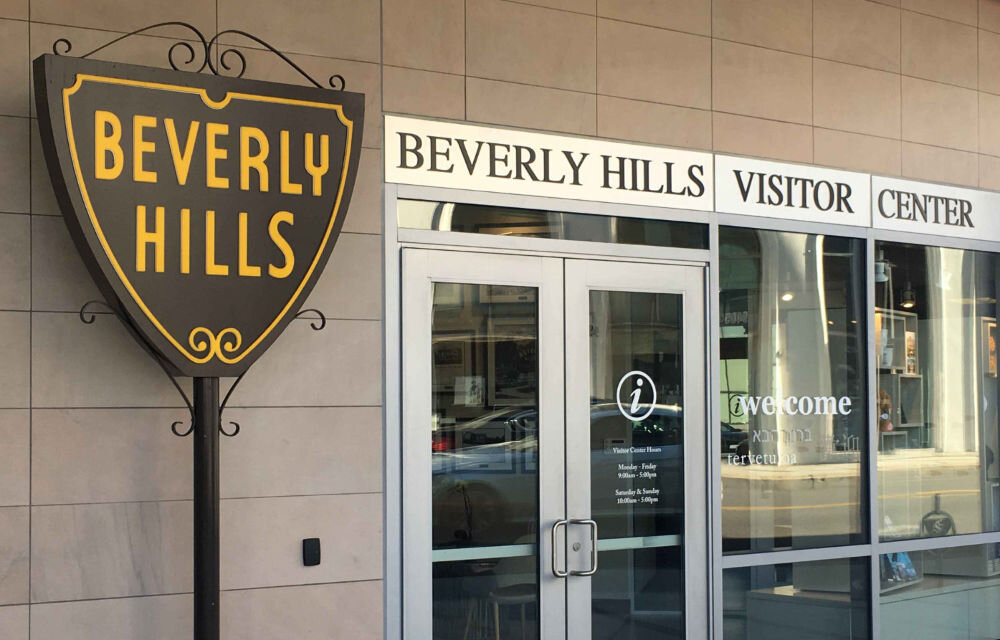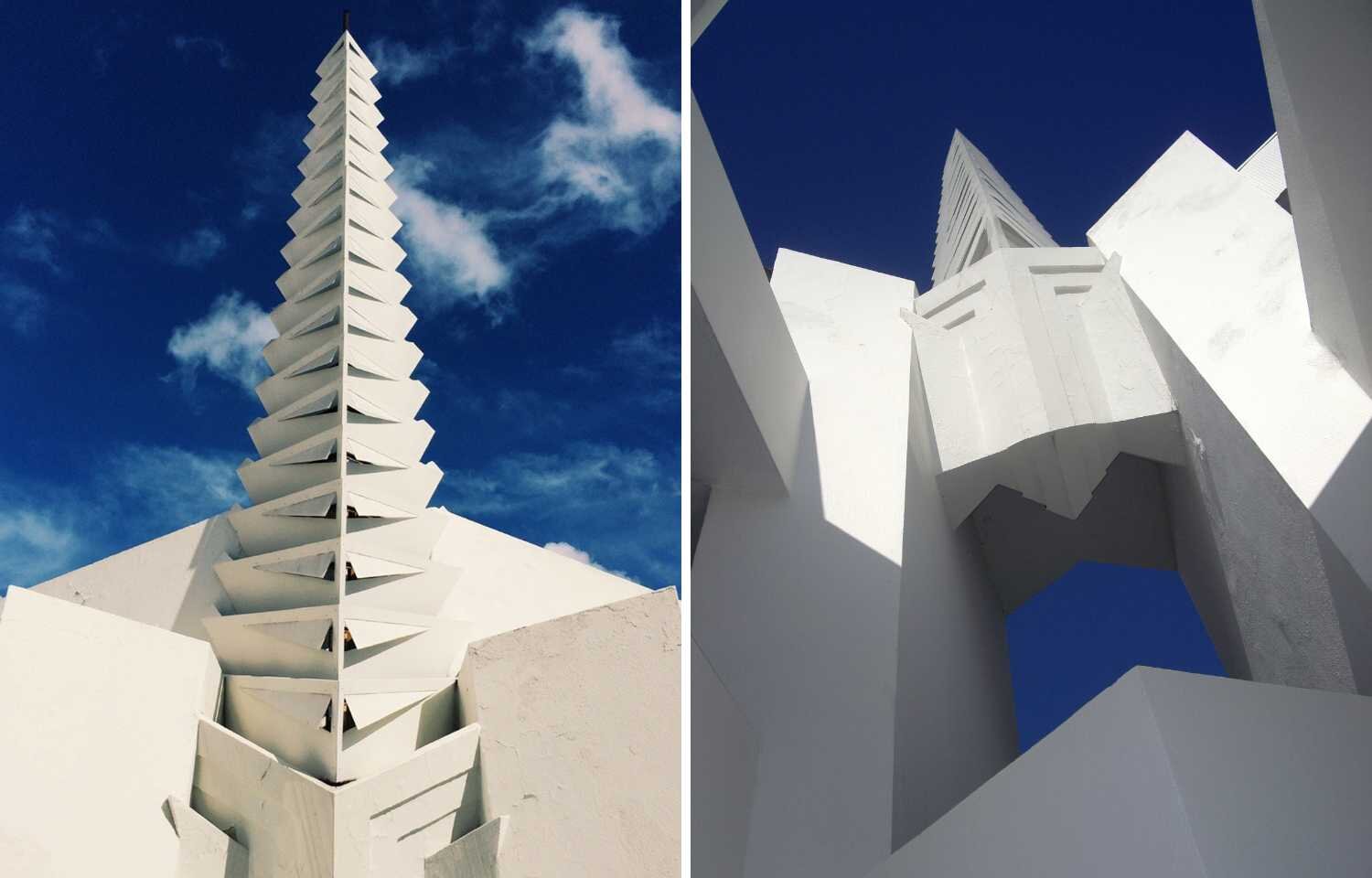RODEO DRIVE walking TOUR
The Beverly Hills Historical Society welcomes you to our walking tour of the Rodeo Drive and the Beverly Hills retail district known as the Golden Triangle. Below you'll find the route map and list of addresses on the tour. To enhance your tour experience, some stops also include a short video.
legend
stop 1 - the lily pond / beverly gardens park
9439 santa monica blvd
The Lily Pond and its 40-foot-long Beverly Hills sign have been local landmarks since 1907. The pond was originally installed as a real estate promotion to entice homebuyers. The City didn’t have any trees or houses yet, but when potential residents arrived at the train station across the street, the Lily Pond greeted them. It was an oasis in the barren Southern Californian desert.
The original sign fell into disrepair and disappeared. Then, in 2014, to celebrate the City’s centennial, civic leaders with generous support from residents restored the Lily Pond and the sign to their original glory.
For more about Beverly Hills parks and the history of one of the most famous signs in the world, watch the video below.
stop 2 - beverly train station
Santa Monica Blvd & North Cañon Dr
This block was originally the center of Beverly Hills because the tiny train station provided the only gateway to the City. Freight trains and the Pacific Electric Red Car passenger line shared the right-of-way that ran along Santa Monica Boulevard. The trains are long gone, but the median still divides Santa Monica Boulevard, also known as historic Route 66. The area eventually evolved into the center of government and culture with the construction of the Beverly Hills City Hall, the post office, the Civic Center, and the Wallis Annenberg Center for the Performing Arts.
stop 3 - wallis annenberg center
9390 n santa monica blvd

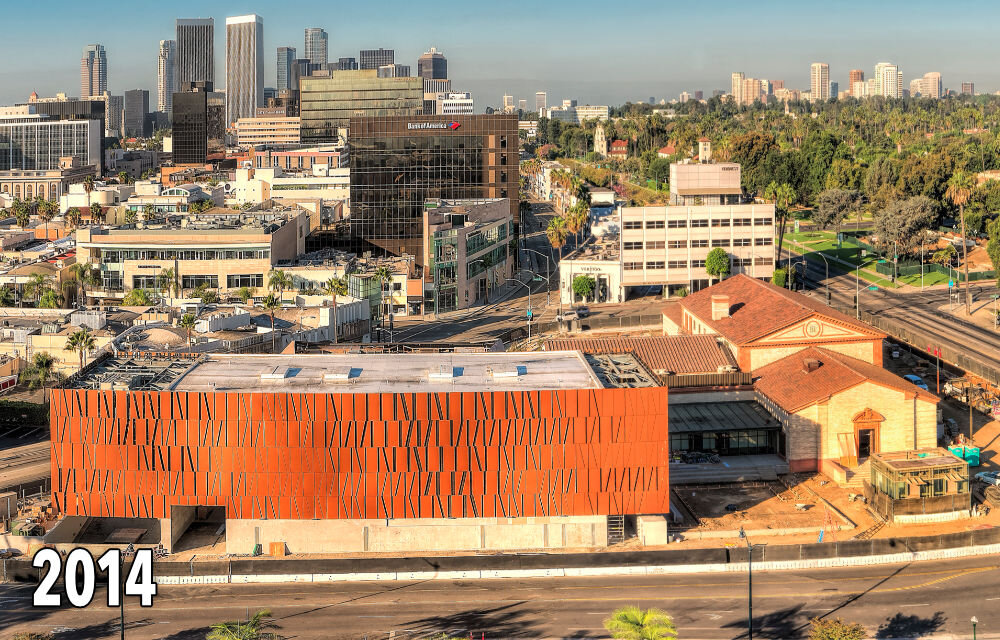
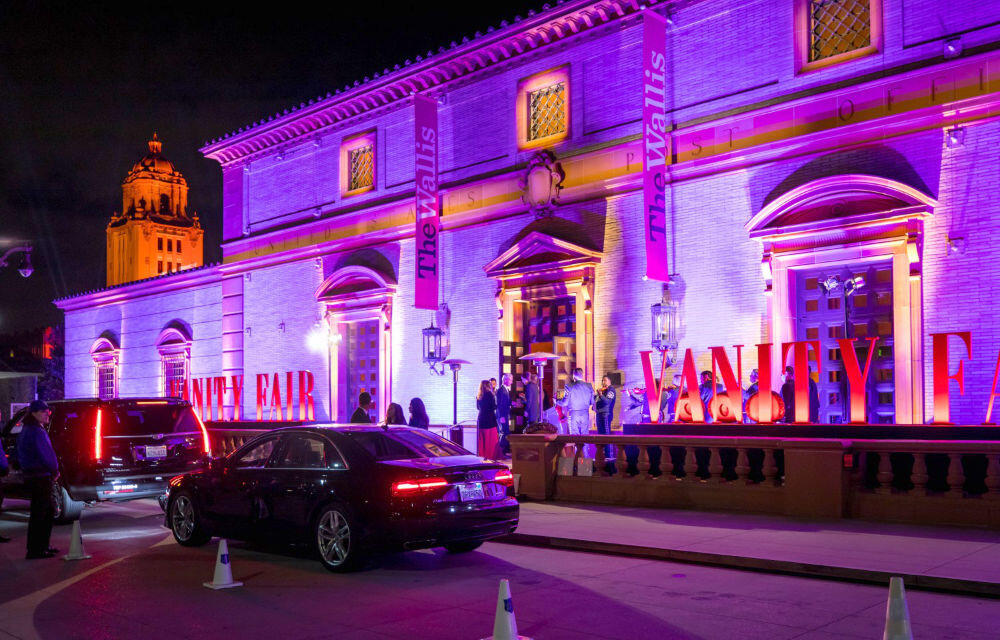
The site of the Wallis Annenberg Center for the Performing Arts was once home to the main Beverly Hills Post Office. Built in the classic Italian Renaissance style, the post office first opened in 1934 thanks to the political influence of Honorary Mayor Will Rogers. It was eventually designated Local Landmark No. 5 on the Beverly Hills Register of Historic Properties. The lobby is decorated with fresco murals depicting modern life during The Great Depression. Many movie stars picked up their fan letters here, but only Beverly Hills resident Fred Astaire tap-danced on the marble floor if his mail was not ready. The building now boasts a state-of-the-art theater complex and annually hosts the famous Vanity Fair magazine Oscar party.
stop 4 - beverly hills city hall
Santa Monica Blvd & North Crescent Dr
Beverly Hills City Hall is a Spanish Revival-style building recognized for its blue, green, and gold tile dome and gilded cupola. It also features marble floors and carved wooden ceilings. Completed in 1932, it has been featured in many films including In a Lonely Place (1950) starring Humphrey Bogart and Beverly Hills Cop (1984) starring Eddie Murphy. An archival photo from 1930 shows the City Hall about to open with the original fire station to the south. The Sun Lumber Company originally occupied the site of the current police station and library. City Hall is Local Landmark No. 12 on the Beverly Hills Register of Historic Properties.
stop 5 - mca building
360 North Crescent Dr
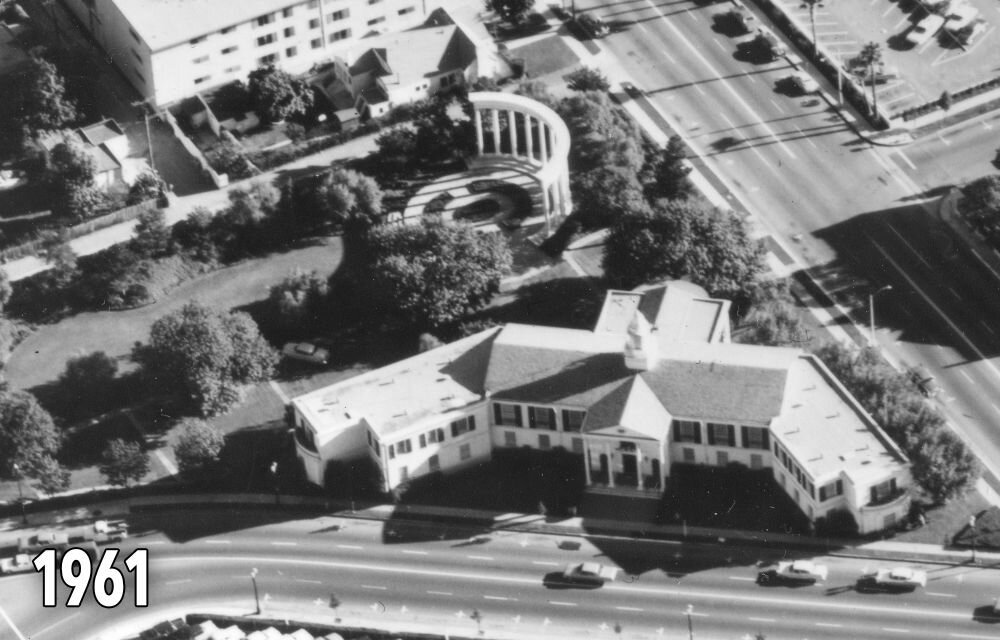
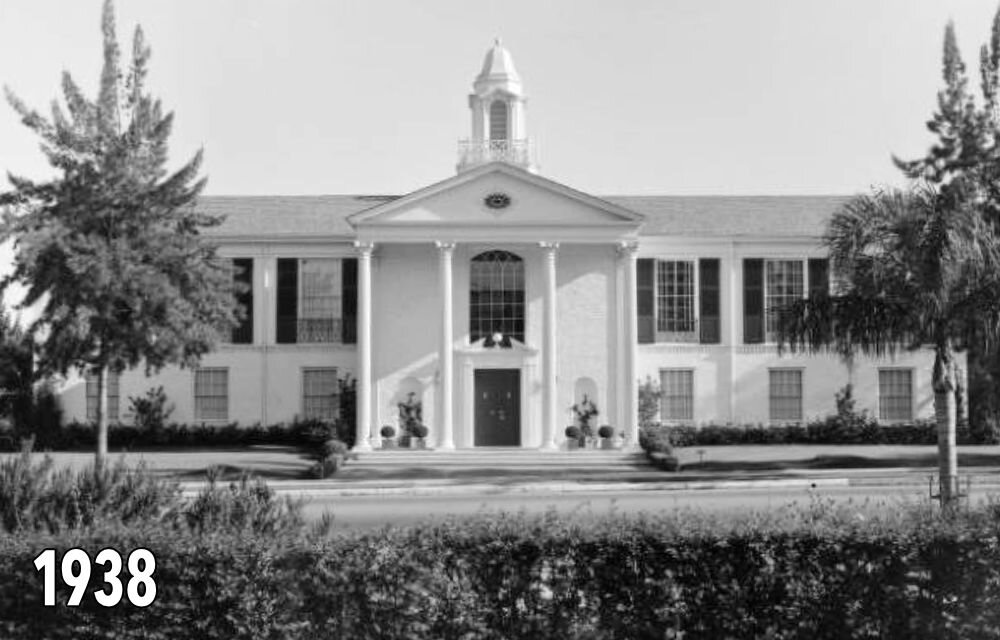
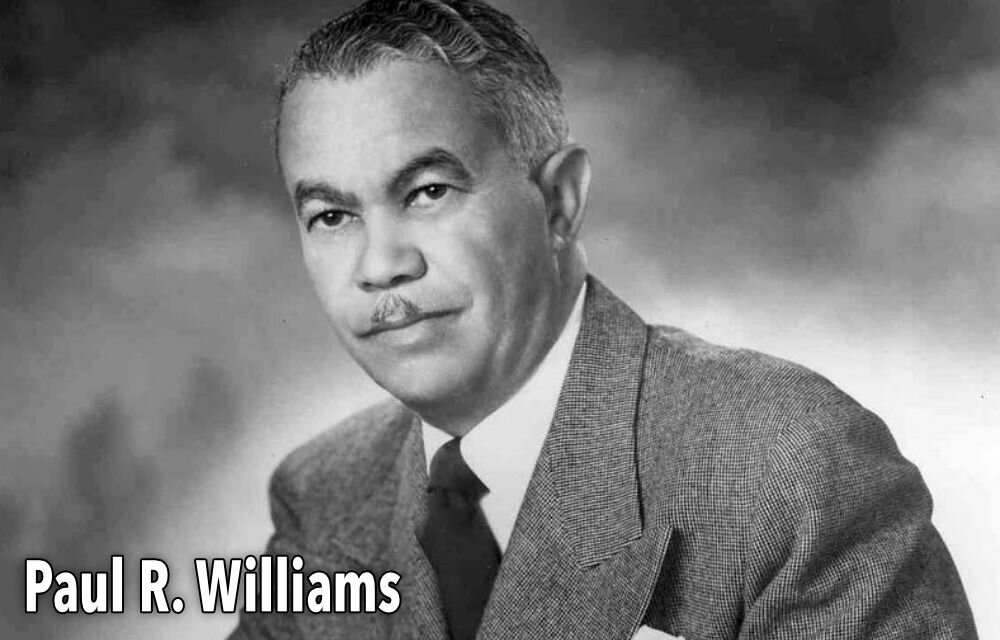
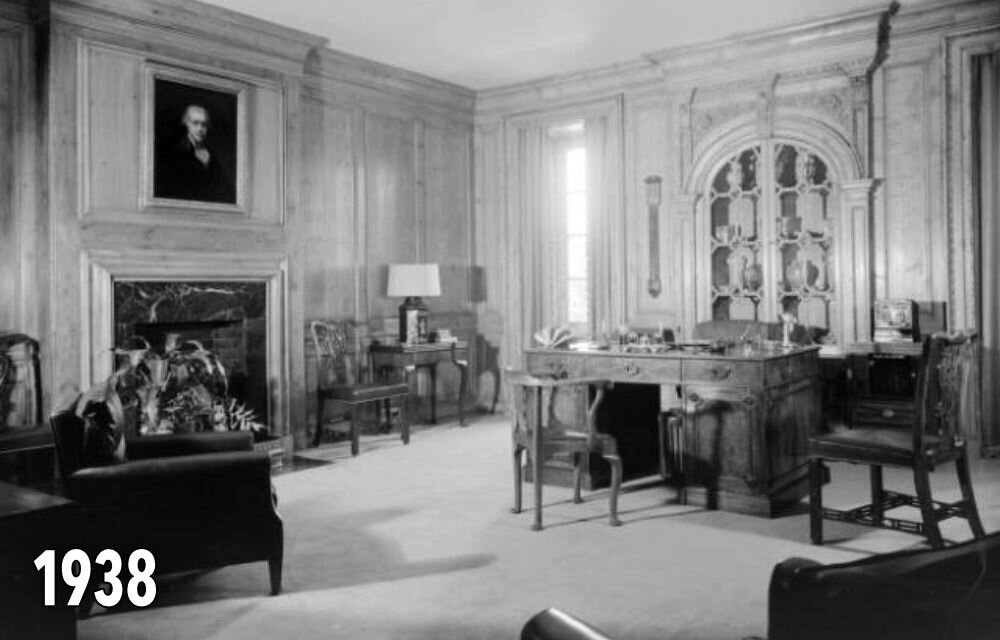

World-renowned architect Paul Revere Williams designed the MCA Building in 1938. It became home to famous show business agents Lew Wasserman and Jules Stein who represented the biggest names in Hollywood including Marilyn Monroe, Cary Grant, Judy Garland, Henry Fonda, Grace Kelly, and Kirk Douglas. From the massive antique iron gates to the green shutters, portico, cupola and ornate gardens complete with fountains and statuary, the grounds had a residential feel even though the main building contained over 30 offices, a radio station, projection room, and even a hidden bar. The lush interior details and antique-like furnishings put MCA's elite Hollywood clientele at ease.
stop 6 - union 76 gas station
427 North Crescent Dr
In 2017, Beverly Hills designated this space-age gas station as Local Landmark No. 37 on the Beverly Hills Register of Historic Properties. There had been a more conventional service station here since the early 1920s, but in 1965, this new modernistic station was designed by architect Gin D. Wong of William L. Pereira and Associates, who is also credited as designer of the LAX Theme Building. When it officially opened, sales skyrocketed from 100,000 to 150,000 gallons of gasoline per month.
stop 7 - edelweiss chocolates
444 North Cañon Dr
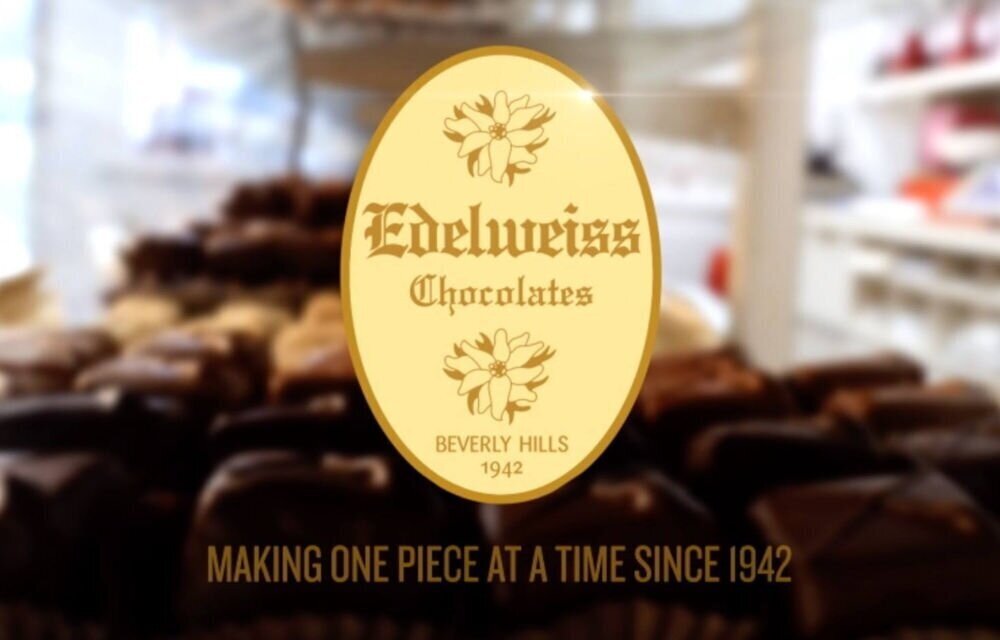

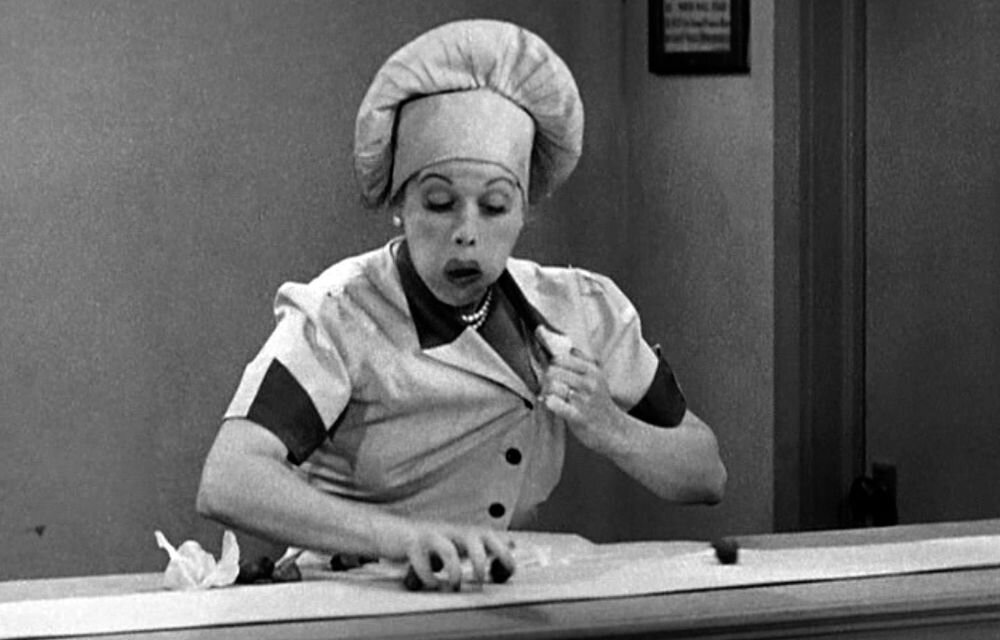
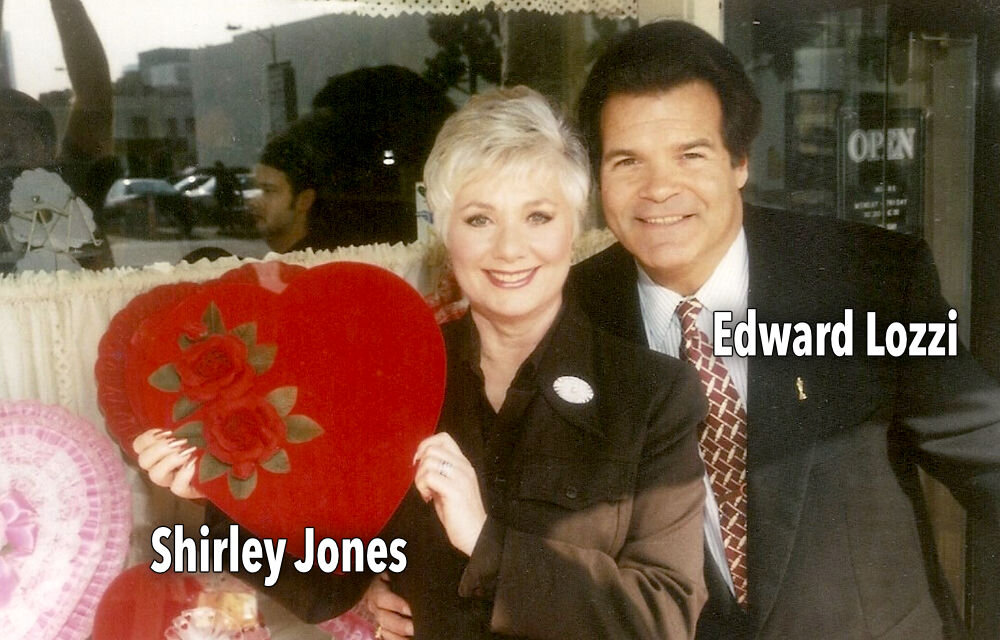
In this location since 1942, Edelweiss has always attracted stars with a sweet tooth. Frank Sinatra loved the maple creams. Lauren Bacall and Katherine Hepburn were partial to the chocolate turtles. Lucille Ball got the idea for the famous I Love Lucy chocolate factory episode when she entered through the back and saw the candy-making conveyor belt. In 1996, agent Marty Ingles purchased the store for his wife, actress Shirley Jones. Today, stars like Reese Witherspoon, Jennifer Garner, and Arnold Schwarzenegger can be found hunting through the 85 different chocolates Edelweiss offers.
stop 8 - La Scala
434 North Cañon Dr
La Scala owner Jean Leon (right) with actors Tony Franciosa and Zsa Zsa Gabor (left).
La Scala opened in 1956 and moved to its current location in 1989. The owner, Jean Leon, and original chef, Emilio Nunez, introduced innovations like white truffles and house-made pasta, but the restaurant is best known for its chopped salad. Over the years, La Scala served hundreds of Hollywood luminaries and six U.S. presidents. Stars from Charlie Chaplin and Judy Garland to Warren Beatty and Leonardo DiCaprio all dined at this famous eatery. Robert Wager proposed to Natalie Wood in one of the famous red booths, and Elizabeth Taylor had La Scala food delivered to Europe while she was filming Cleopatra.
stop 9 - the courtyard building
427 North Cañon Dr
Early retail spaces in Beverly Hills were built around arcade courtyards. Of the dozen that once filled the City, this is the only one that remains. This approach to shopping was very popular and the opening of the Anderson Arcade Building at 450 North Beverly Drive in the 1930s was a gigantic event. It was built by Stanley Anderson, manager of the Beverly Hills Hotel and son of its owner, Margaret Anderson. It was designed by W. Asa Hudson, the first architect to permanently move to Beverly Hills.
stop 10 - beverly hills visitor center
9400 South Santa Monica Blvd
The distinctive Beverly Hills shield is an icon known around the world. The one outside the Beverly Hills Visitor Center is a half-height replica of the street signs that decorate the gateways to the city on all the major thoroughfares. This sign is placed safely out of traffic lanes and it’s just the right height for the perfect photo op. The concierge staff will happily help you take a picture, and the sign is illuminated at night for an extra special selfie after sunset.
stop 11 - nate'n al's
414 North Beverly Dr
Early Beverly Drive was filled with modest shops that catered to the needs of local residents. J.J. Newberry’s five and dime, a pet store, drug story, candy store, toy store, and neighborhood grocery. Businesses were tucked away inside courtyards with ornately decorated facades. In 1945, Al Mendelson and his partner, Nate Rimer, opened Nate‘n Al’s, a deli that held a mere 30 customers. It was an instant hit. Movie stars, directors, producers, and writers started dropping by for a matzoh ball, a little kibitzing, and maybe a deal. They’ve been coming back ever since.
stop 12 - first commercial building
465 North Beverly Dr



The first commercial building in Beverly Hills opened in 1907 as a real estate office and hardware store. It later became the First National Bank and then the Bank of America. In 1996, the Museum of Television and Radio building was designed by renowned architect Richard Meier, the creative mind behind the Getty Center. It was renamed the Paley Center for Media and hosted unforgettable screenings and panel discussions with celebrated TV actors, directors, and producers. It also housed a collection of more than 150,000 classic radio and television programs.
stop 13 - rodeo retail
Rodeo Drive & South Santa Monica Blvd

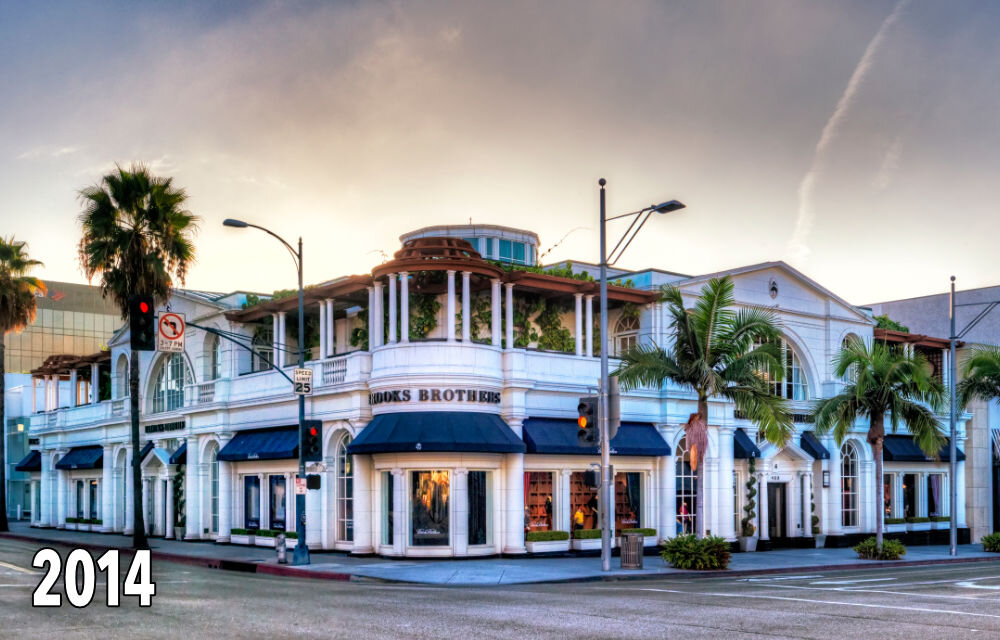

The corner of Rodeo Drive and South Santa Monica Boulevard has long been an iconic retail location. It’s where Richard Carroll defined Rodeo Drive by making shopping for men’s clothing a luxury experience. The site has also been home to Tommy Hilfiger, Brooks Brothers, and the Louis Vuitton X Exhibition. Over the years, Rodeo became an internationally known shopping destination that included the most influential and revered jewelers, couturiers, and purveyors of fine wares from around the world.
stop 14 - horses & horsepower
North Rodeo Drive

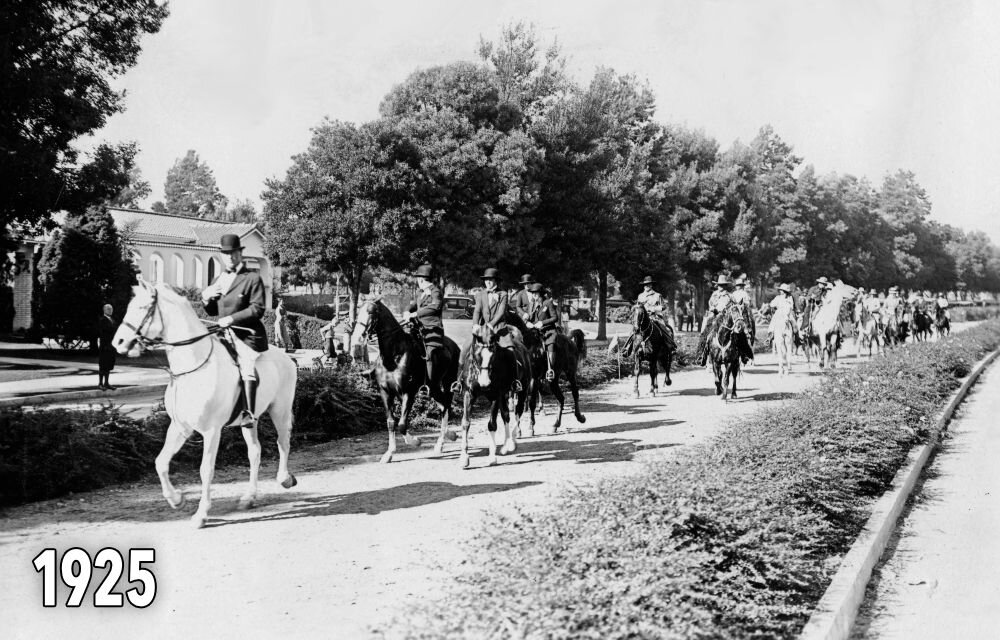


Before the days of swimming pools, almost every house north of Sunset Boulevard had its own stables. In those days, there was no traffic and the street signs said, “Horses have the right of way.” In the roaring ‘20s, the southern part of the City was dominated by the Los Angeles Speedway that hosted 80,000 spectators for the 1924 Speed King of the Year championship race. You could still ride your horse down Rodeo until the mid 1950s when the sleepy street started to transform into a legendary destination. The flowerbeds in the middle of the street are a remnant of the bridle path that once ran up and down Rodeo.
For more about the influence of horses and horsepower on Beverly Hills, watch the video below.
stop 15 - rodeo bean fields
North Rodeo Drive
The land we now know as Beverly Hills was a treeless desert until the 20th century. The picture above, taken in 1888, shows farmers struggling to raise lima beans near what is the now legendary Rodeo Drive. Sheepherders, cattle ranchers, and oilmen all tried to make the land pay off, but it was real estate that eventually defined the town. In 1914, Beverly Hills had only 88 residents. A little more than a century later, Rodeo Drive attracted an unprecedented 7.4 million tourists to the city.
stop 16 - beverly hills walk of style
North Rodeo Drive
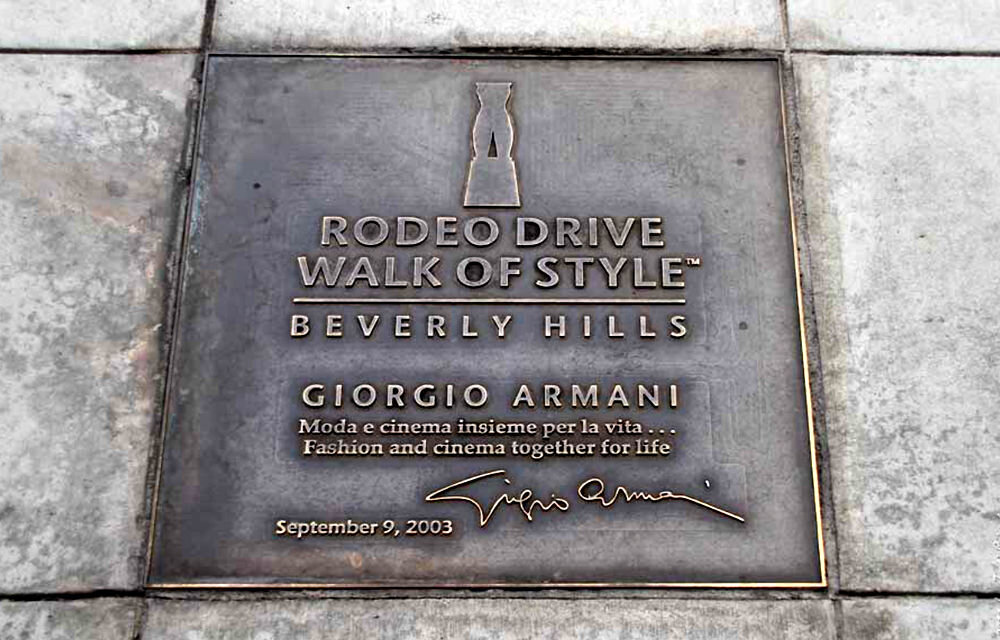
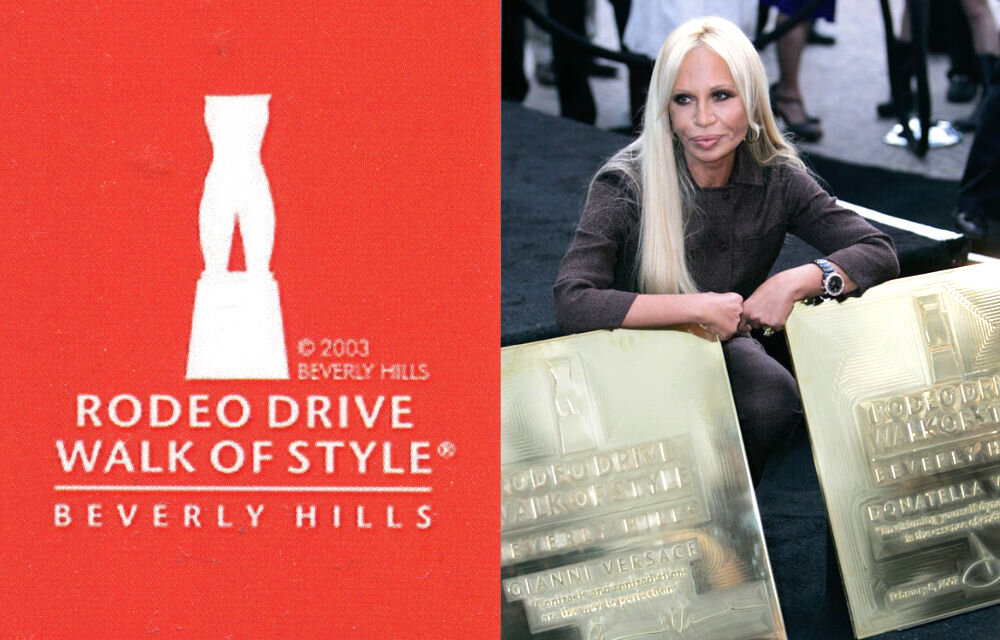
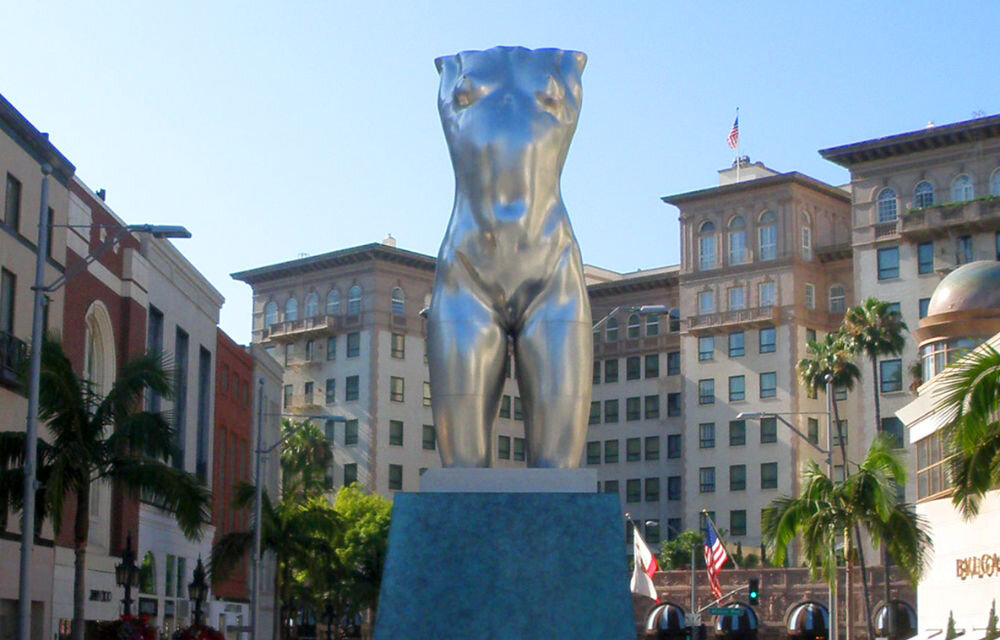
The Walk of Style honors fashion industry icons and innovators. Bronze plaques embedded in the sidewalks commemorate inductees including Giorgio Armani, Tom Ford, Salvatore Ferragamo, Manolo Blahnik, Valentino Garavani, Cartier, Fred Hayman, Missoni, and Bulgari. Donatella Versace accepted her plaque in 2007 as well as a posthumous honor for her brother, Gianni. A statue entitled Torso, specifically designed for the Walk of Style by world-renowned artist Robert Graham, graces the intersection of Rodeo Drive and Dayton Way. It’s 14-feet tall and made from solid aluminum blocks mounted on a bronze pedestal.
stop 17 - anderton court
332 North Rodeo Dr
Frank Lloyd Wright may be the most recognized and celebrated American architect. The Anderton Court Shops is his only retail structure. He described the building with its distinct Streamline Moderne and Art Deco spires, spiral ramp, and central light well as, “a little gem of an unusual sort.” Commissioned by Mrs. Nina Anderton in 1951 with a strict budget of $80,000, it was to be named after her friend, couturier Eric Bass. When they had a falling out, construction was halted. Wright convinced Anderton to continue and the building was completed in 1954 at almost double the original estimate.
stop 18 - beverly hills hot spot
326 North Rodeo Dr
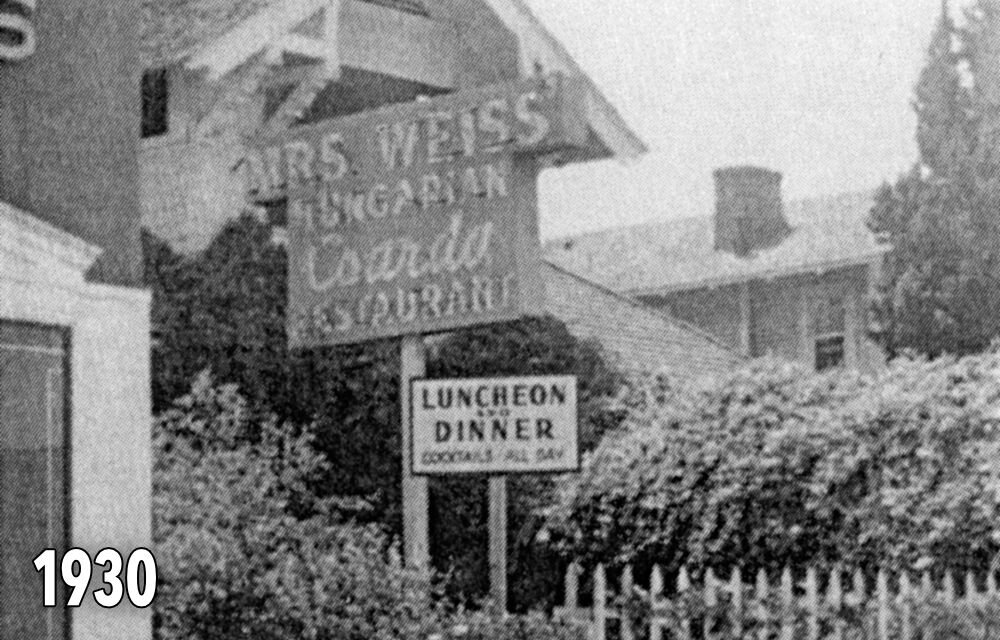
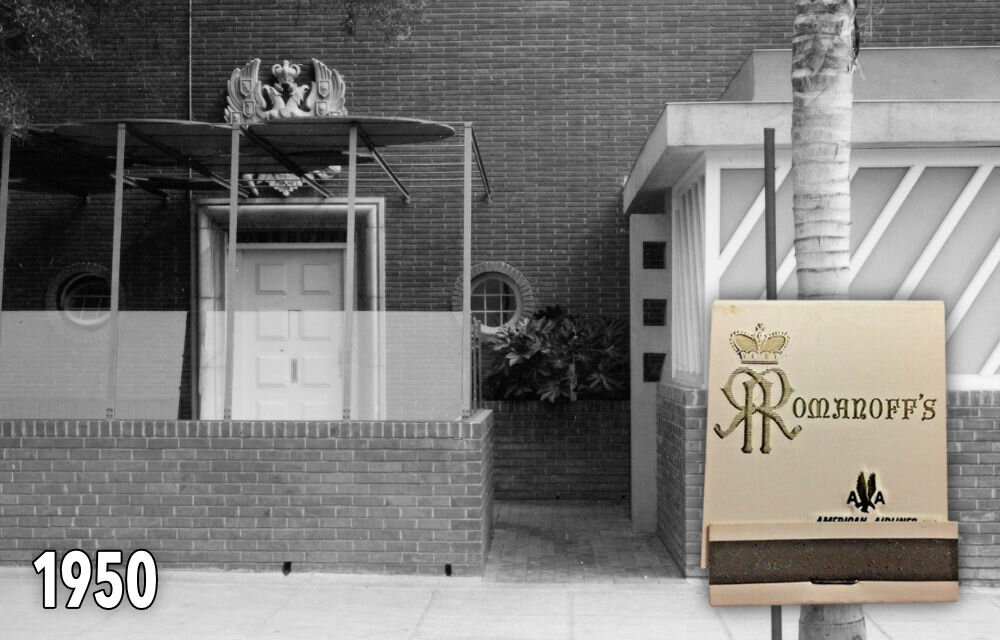
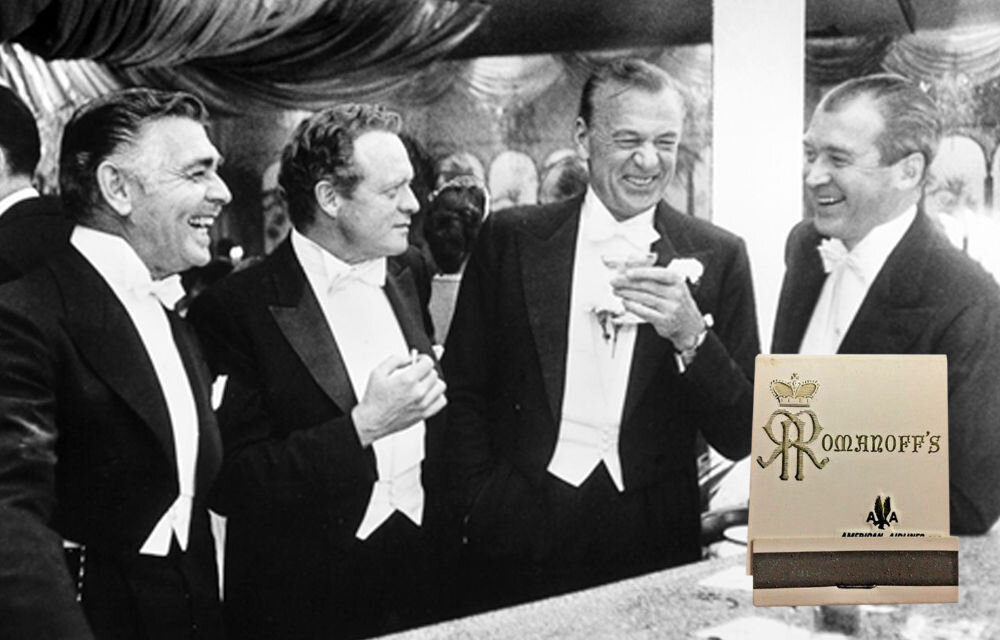
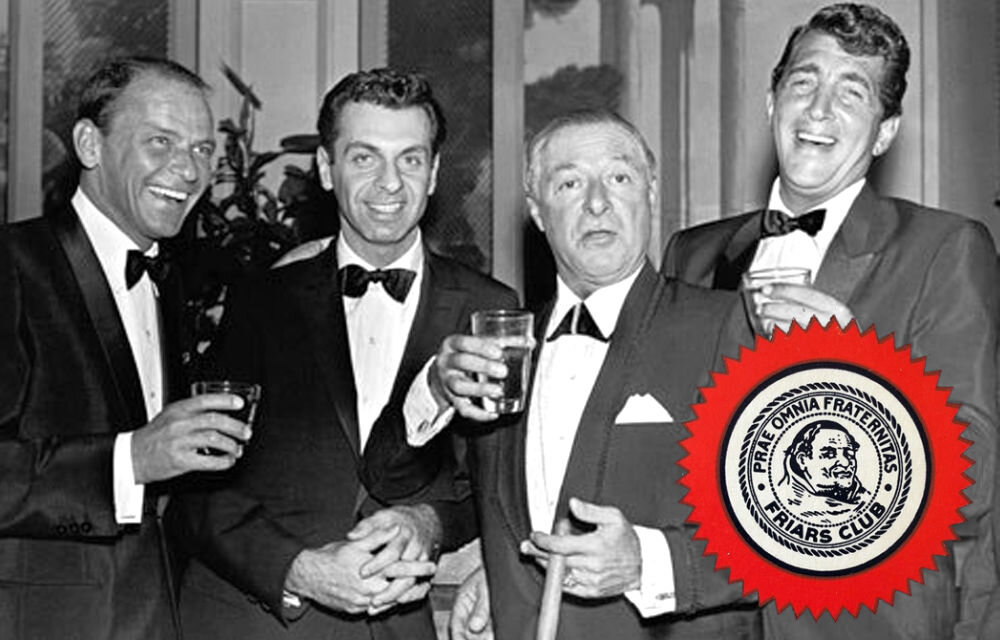

This was originally the site of Mama Weiss' Hungarian Restaurant frequented by Dracula star Bela Lugosi. In the '40s, it was Romanoff's Restaurant where Hollywood’s biggest stars dined. Owner Michael Romanoff was a con man who claimed to be Russian royalty but was really a former Brooklyn pants presser. The Friars Club, known for scathing celebrity roasts, took over in the ‘50s with members that included Milton Berle, Lucille Ball, and the Marx Brothers. In the Swinging '60s, Jack Hanson built The Daisy into the most popular disco in town. It was one of the first night spots where Frank Sinatra was seen publicly with his soon-to-be third wife, Mia Farrow. In 1974, the cast of Young Frankenstein enjoyed lunch al fresco on the Daisy patio.
stop 19 - two rodeo
North Rodeo Dr & Dayton Way
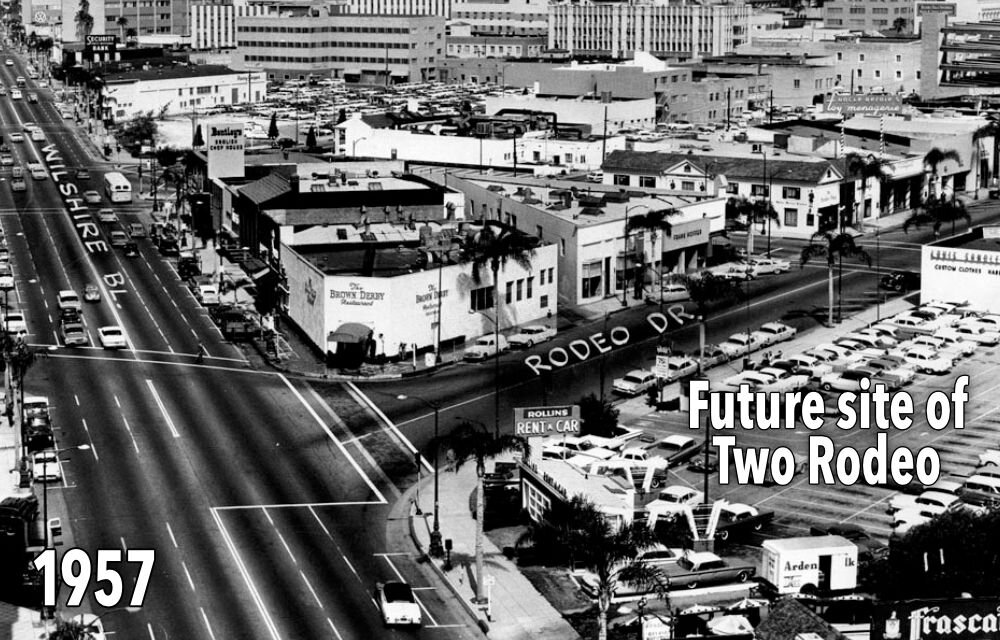
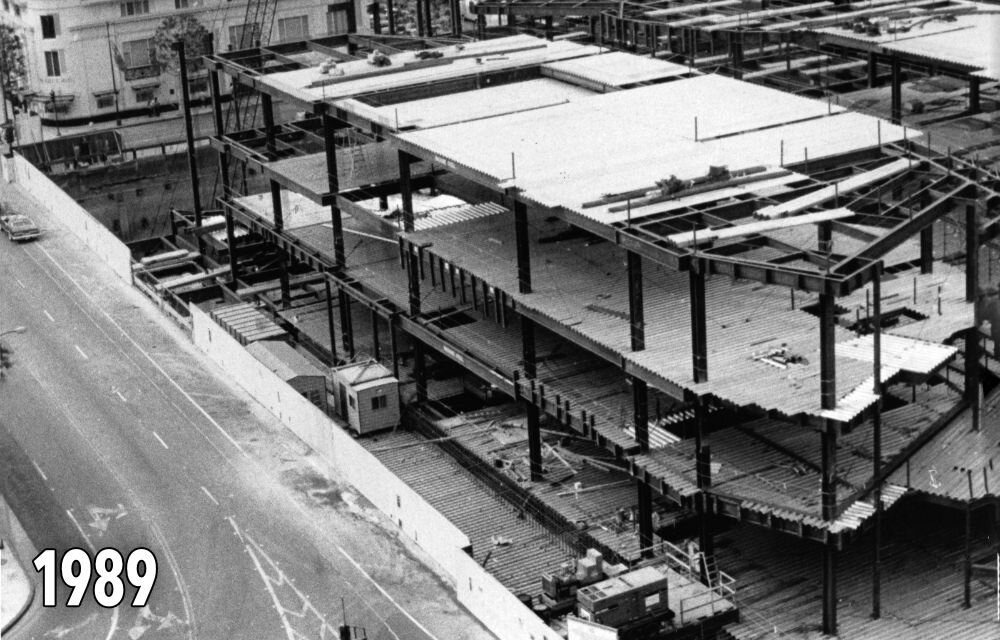
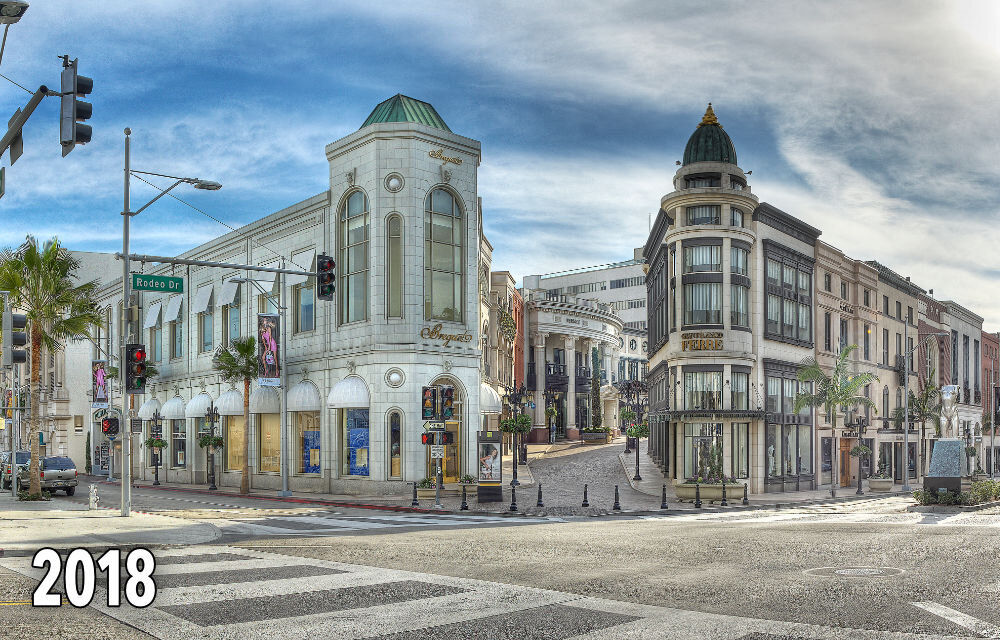
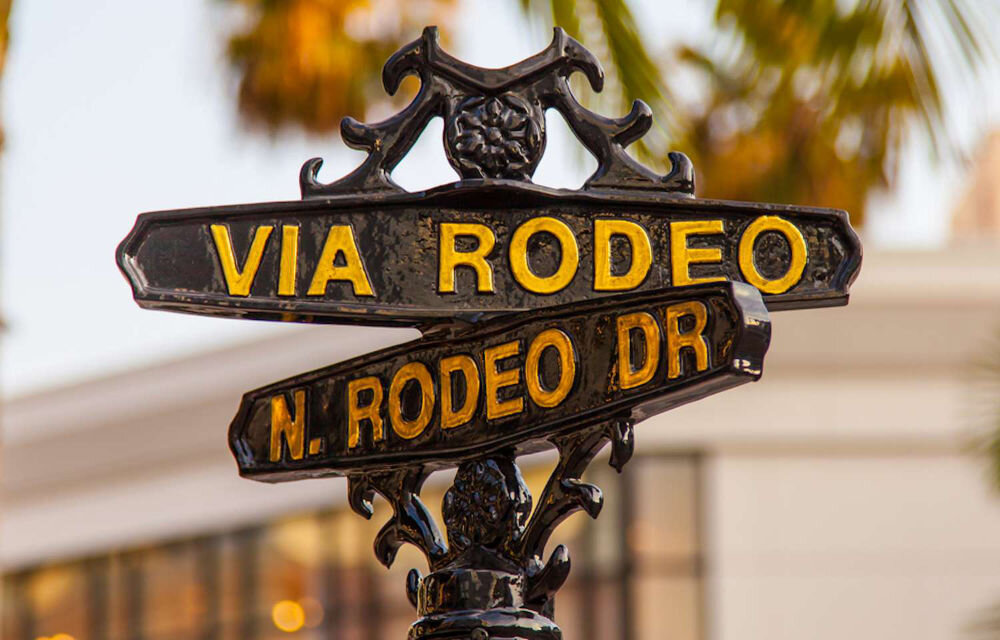
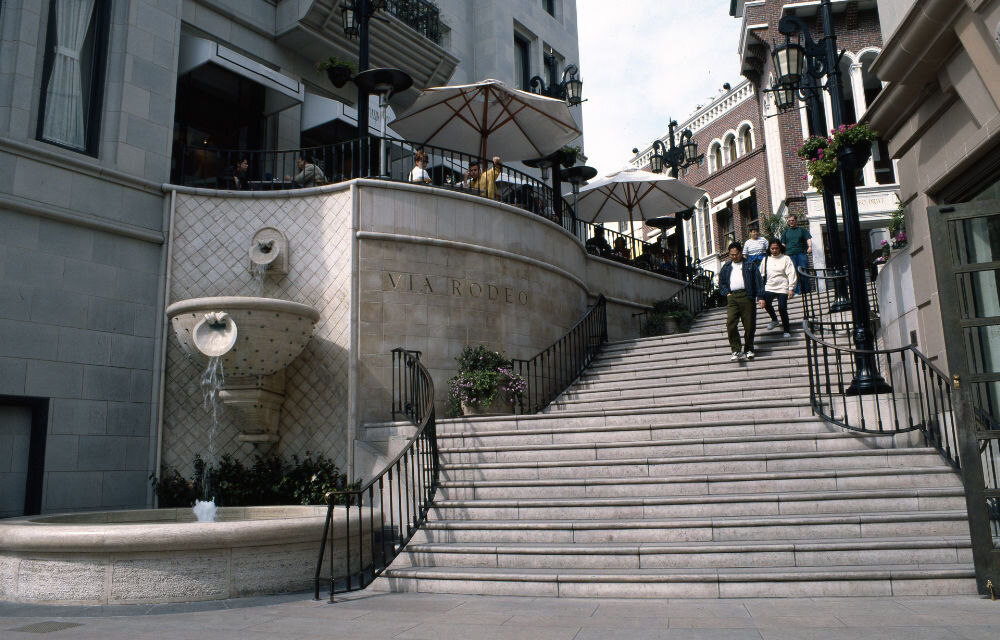
Before Rodeo Drive became the world’s most fashionable shopping destination, this property at the south end was just a parking lot and rental car company. The archival photo above shows the area in 1957 anchored by the Beverly Wilshire Hotel and Brown Derby restaurant. Today, Two Rodeo is the gateway to the glittering heart of Beverly Hills. The iconic Via Rodeo sign marks the north entrance to the shopping center which is designed to look like a beautiful European city whose cobblestone street is lined with luxury stores and eateries.
stop 20 - rodeo drive: then & now
Beverly Hills was once just a barren desert. In just over 100 years, it evolved into the most famous small town in the world. The pictures above, looking north from the top of the Beverly Wilshire Hotel, show the transformation of Rodeo Drive from lima bean fields and orange groves to one of the most famous streets in the world.
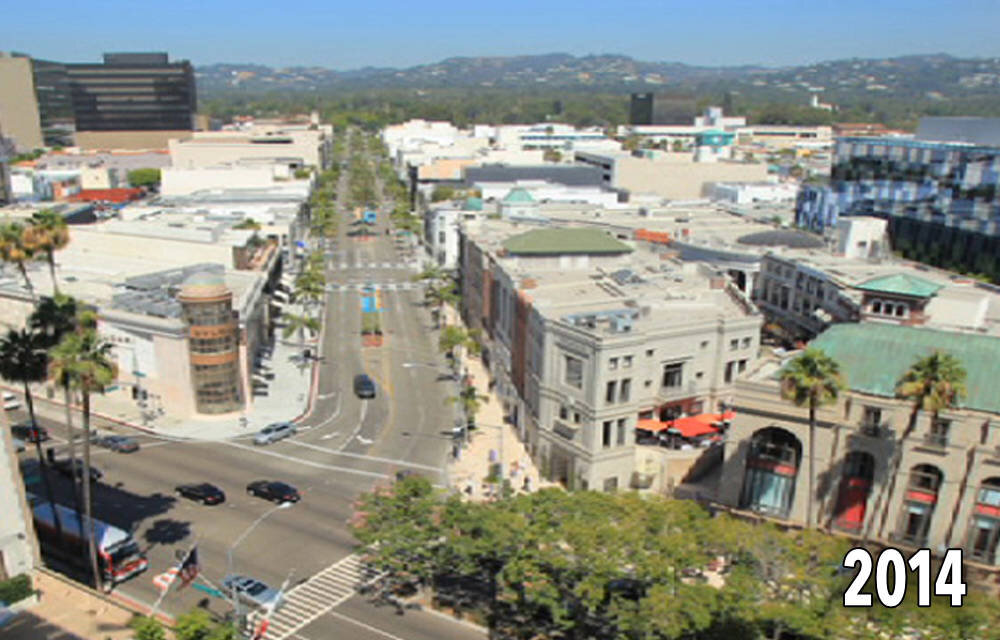

Now might be a good time to take a break from the tour and enjoy a brief video recounting how the City came to be. Or, if you prefer, cross Rodeo Drive and continue the tour.
stop 21 - beverly wilshire hotel
9500 Wilshire Blvd
Built in 1928, the hotel is located on the northeast corner of what was once the giant Beverly Hills Speedway. The track was a mile-and-a-quarter wooden oval and hosted the world championship car race in 1926 that was attended by 70,000 fans. To many, the Beverly Wilshire Hotel is probably most recognizable as the hotel in "Pretty Woman" (1990) starring Julia Roberts and Richard Gere. Celebrities who have called this prestigious hotel home include Elvis Presley and Warren Beatty. It is Local Landmark No. 18 on the Beverly Hills Register of Historic Properties.
BEVERLY HILLS SPEEDWAY (1922) - The southern part of the city hosted an Indianapolis-style auto speedway from 1920 to 1926 when it was torn down and replaced with a residential neighborhood.
stop 22 - the brown derby restaurant
9537 Wilshire Blvd
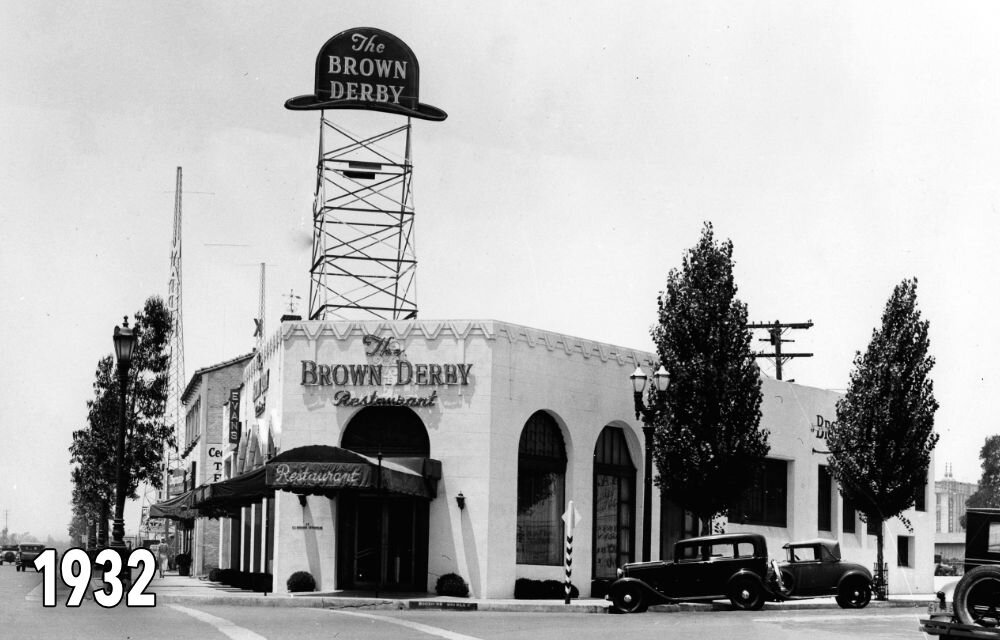
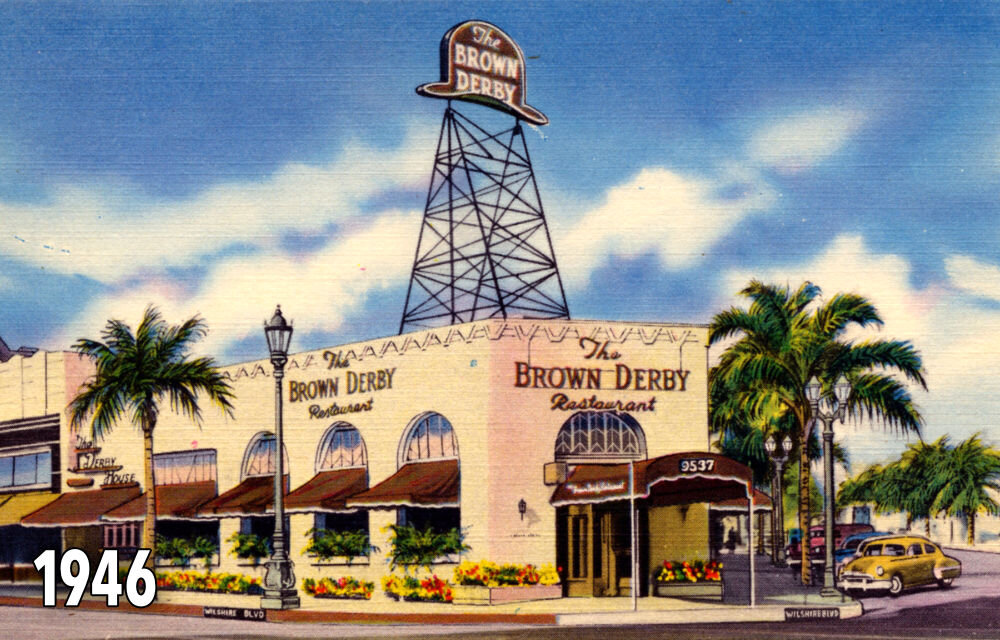

The Brown Derby restaurants were famous for the movie stars dining in the booths and the star caricatures that graced the walls. The eateries were run by Robert Cobb, inventor of the Cobb salad. The first Cobb salad was thrown together from leftovers for theater owner Sid Grauman who needed it finely chopped because of recent dental work. The Beverly Hills Brown Derby opened in 1931 and served its last meal in 1982. The One Rodeo building that replaced it has a derby-shaped dome in honor of the legendary restaurant.
stop 23 - life is beautiful
295 North Rodeo Dr
"Life Is Beautiful" is a sculpture by internationally acclaimed street artist Mr. Brainwash. His real name is Thierry Guetta, and the French-born, Los Angeles-based artist rose to fame as a protégé of Banksy after appearing in his film Exit Through the Gift Shop. When asked to explain his art, Guetta says, “I represent positivity. When you have positivity, everything becomes beautiful.”
stop 24 - giorgio
295 N Rodeo Drive

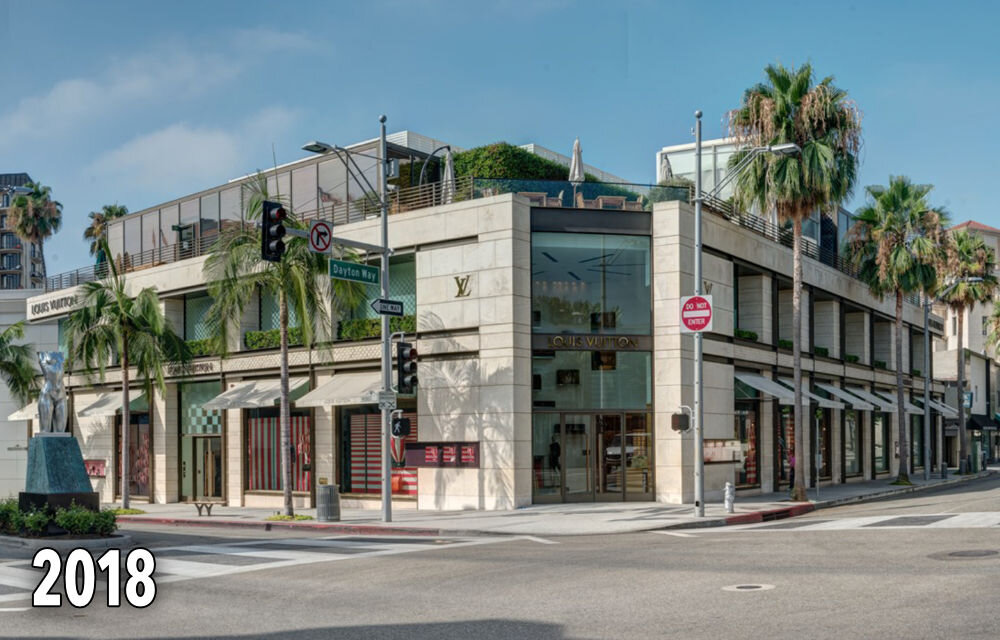
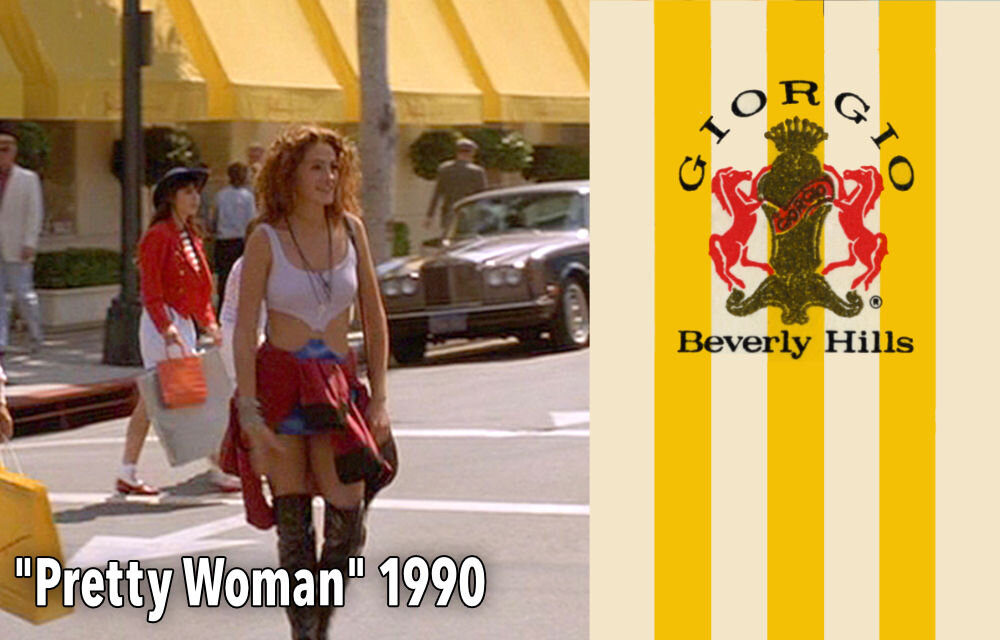
Often called The Godfather of Rodeo Drive, Fred Hayman opened Giorgio in 1967 and turned Rodeo Drive from a local shopping street into an international symbol of style. The lush fashions and celebrity clientele inspired a steamy novel, a popular perfume, and an unmatched image of opulence. In the movie Pretty Woman (1990), Giorgio is the first place Julia Roberts goes shopping with Richard Gere’s credit card. Hayman, formerly the catering manager of the Beverly Hilton Hotel, understood the value of first-class hospitality. At Giorgio, men could play pool and enjoy free cocktails while their wives or girlfriends shopped. Louis Vuitton now occupies this legendary corner.
stop 25 - uncle bernie's toy menagerie
315 North Rodeo Dr
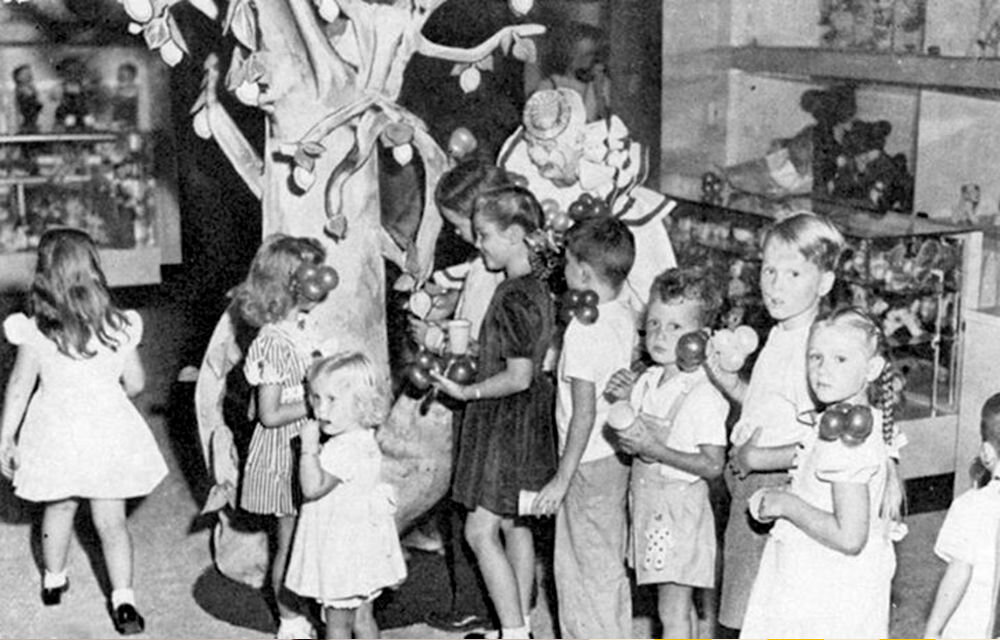
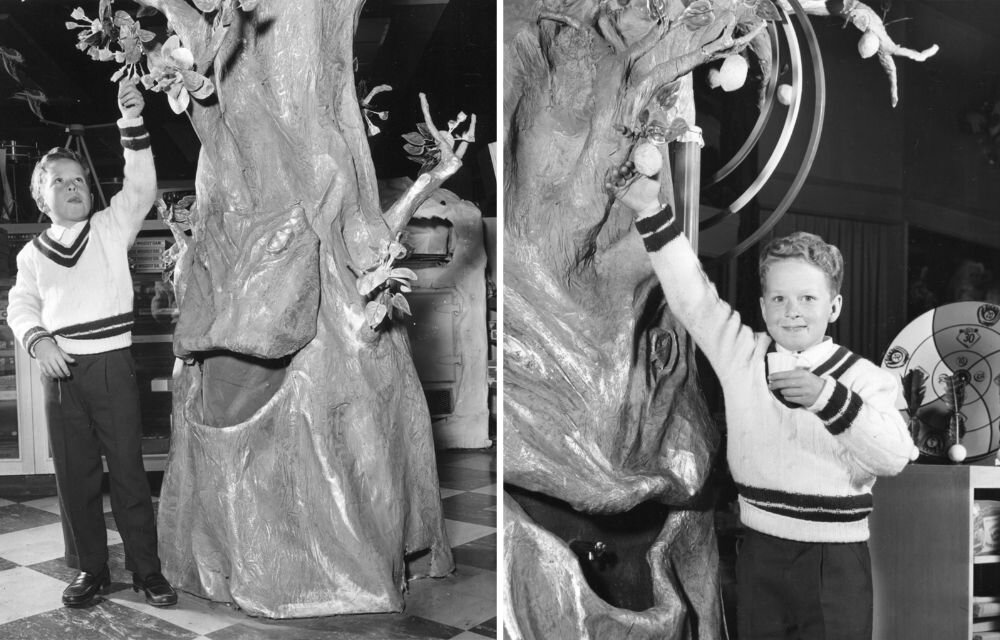
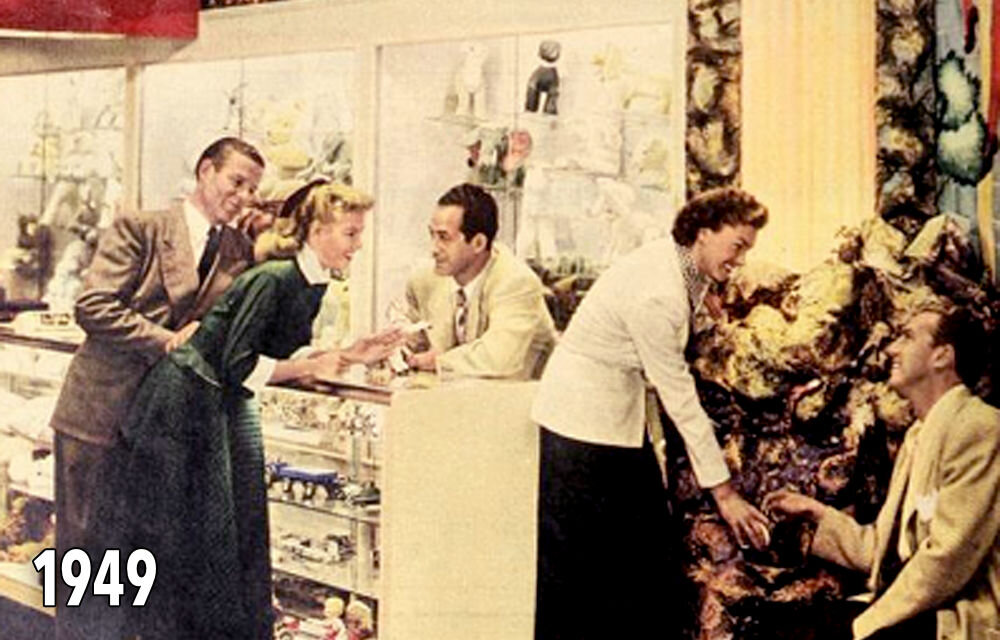
Visiting Uncle Bernie’s was a cherished childhood memory from the early 1940s until 1965 when it was sold to F.A.O. Schwarz. An early postcard described the shop as, “The most beautiful toy store in the world where ice-cold lemonade pours from the famous Lemonade Tree and multicolored candies branch from the Lollipop Tree.” Though Uncle Bernie’s generally catered to children, the store closed on Christmas Eve 1949 so movie star Esther Williams could throw a private party for some grown-up kids.
stop 26 - last house on rodeo
371 North Rodeo Dr
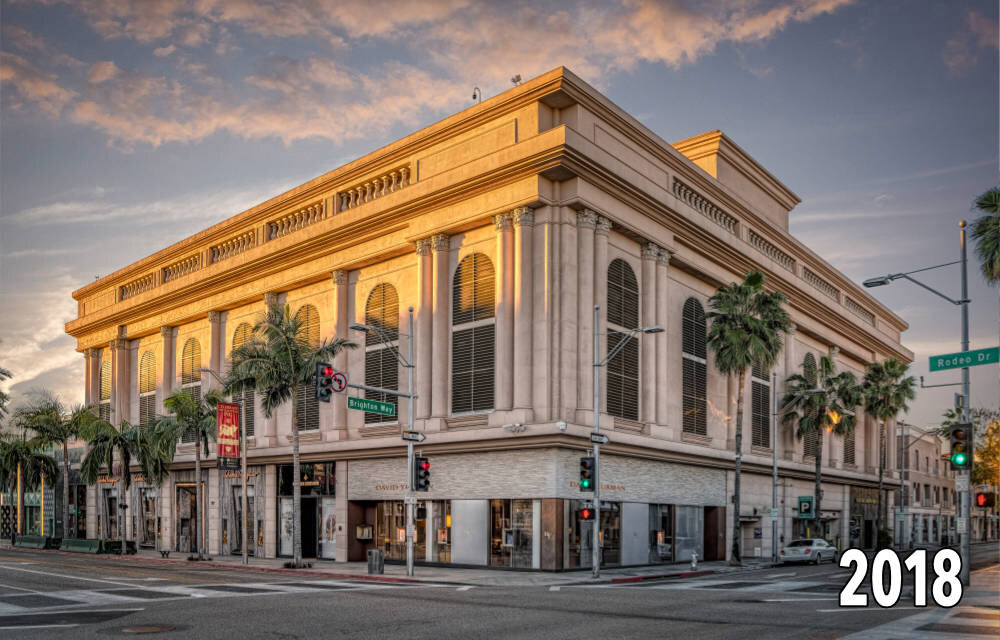
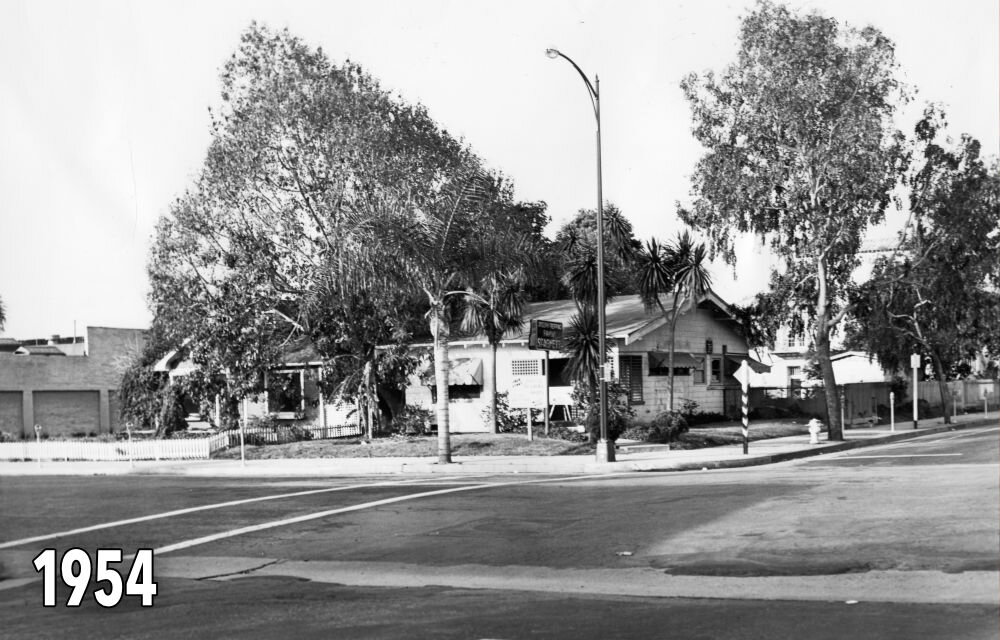
As Rodeo Drive evolved, there were still small houses that remained from the 1920s when it was a residential district. Some of the original bungalows became restaurants like Joseph Reppac’s Famous Spaghetti Restaurant seen in the photo above. The character of the street changed in 1969 with the introduction of Gucci and other international designer brands. Now, the corner where spaghetti was once served is home to top designer brands Ferragamo, Vacheron Constantini, and David Yurman.
stop 27 - the luau restaurant
421 North Rodeo Dr
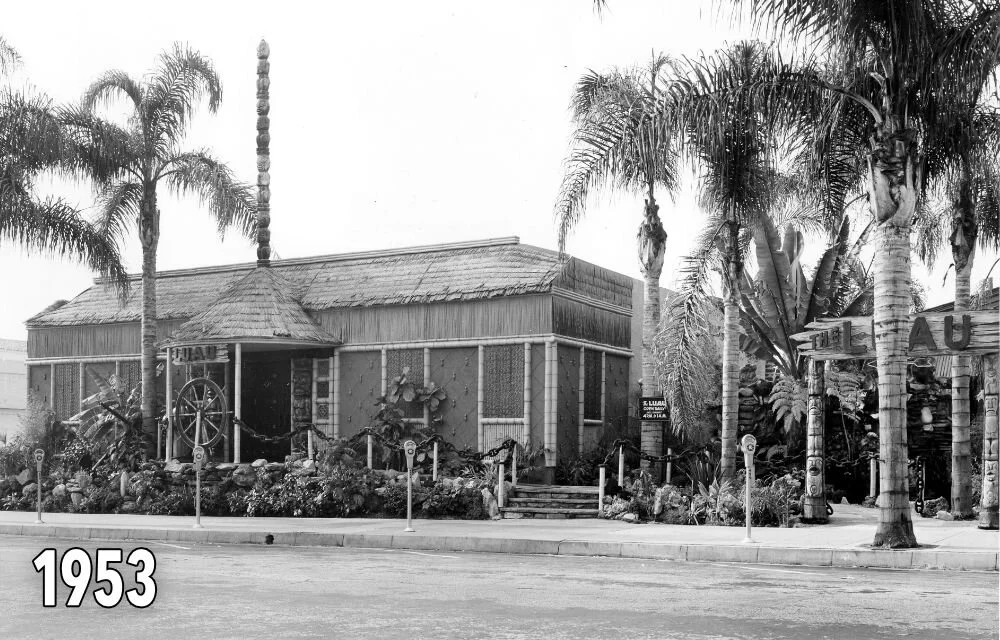
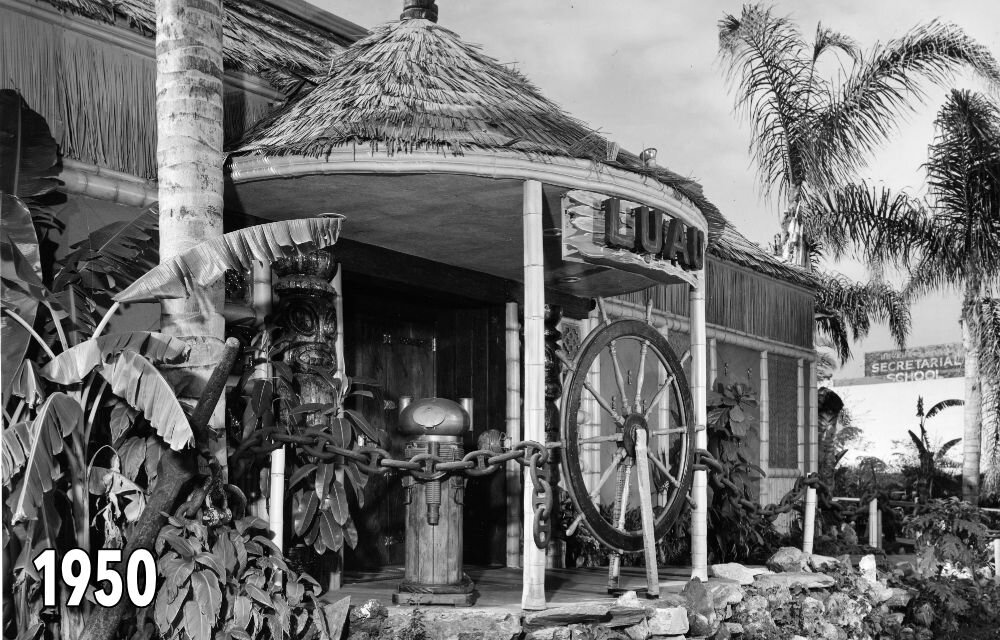

This was the site of a Polynesian-themed tiki bar called Sugie’s Beverly Hills Tropics from1936 until 1953 when it was bought by one of Lana Turner’s ex-husbands, Steven Crane. Their daughter, Cheryl, notorious for stabbing Turner’s gangster boyfriend, Johnny Stompanato, was the restaurant’s hostess. The menu read, “Aloha! You have just crossed the gangplank into Paradise, or such is the illusion that we of The Luau hope to create.” In addition to the fish-filled streams and ornate bridges, The Luau boasted an indoor lagoon with miniature bamboo ships. It closed in 1978.
stop 28 - writers and artists building
9507 South Santa Monica Blvd
The Heegaard Building, constructed in 1924, was the tallest building in downtown Beverly Hills. Honorary Mayor Will Rogers kept an office there. So did United Artists partners Charlie Chaplin, Mary Pickford, and Douglas Fairbanks. Ray Bradbury wrote in Suite 204. Screenwriter and director Billy Wilder and actor Jack Nicholson had offices here. The directory also lists Dan Petrie, Jr. who wrote Beverly Hills Cop (1984) in Suite 303. There is a rumor the building is haunted at night by the ghosts of long-dead screenwriters still waiting for their agents to call.
stop 29 - art in the park
Santa Monica Blvd & North Rodeo Dr
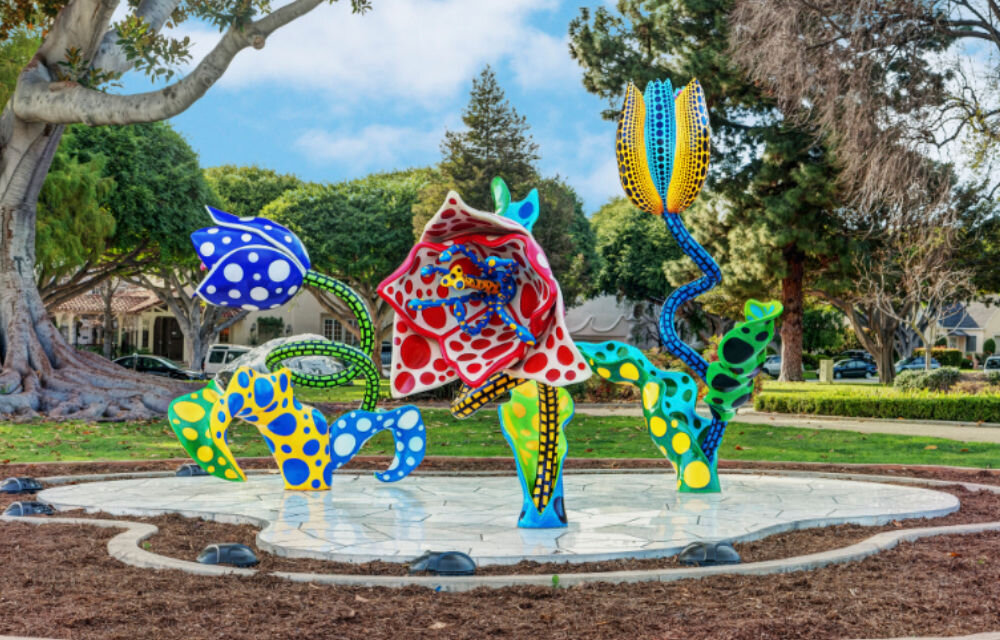
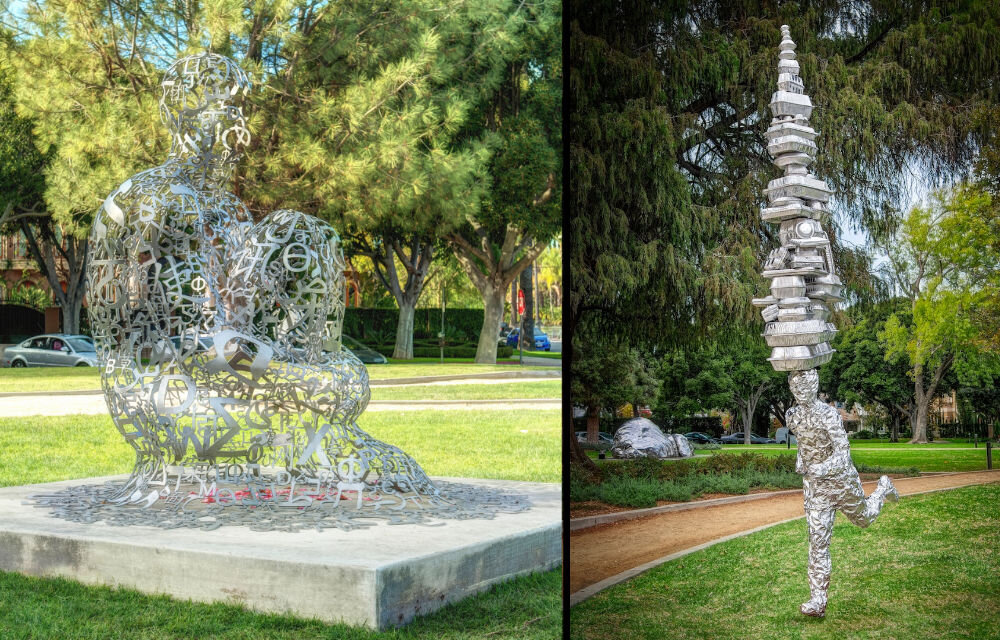

The City of Beverly Hills Fine Art Program promotes the City's cultural image by collecting and displaying world-class art that reflects a diversity of artists and visions, enhances the everyday experiences of citizens, and assures accessibility to everyone. As a result, Beverly Hills is home to many incredible works of art available for the enjoyment of the public. The City website hosts several interactive maps including one that offers a self-guided tour of the artwork throughout Beverly Hills.

